Feed aggregator
Monday Meows
Stalking the wild martini, shhhhhh!
Dude, you know you don’t drink.
Cat. Some assembly required.
What is it with tuxedo-boys? I’m so embarrassed.
You think you’re embarrassed, try wearing the same suit as…that.
We’ve been thinking of dying this one black and white to match the set.
Nero Wolfe’s Brownstone – 3 Good Reasons: ‘Black Orchids’
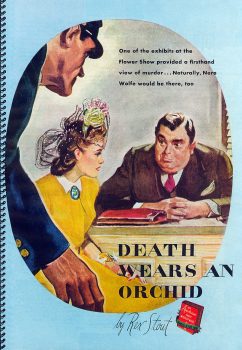 What flummery is this? I have not written about Nero Wolfe since last Summer? There has not been a 3 Good Reasons in four years? What kind of mystery blogger is this Bryne fellow? Most unsatisfactory. So…
What flummery is this? I have not written about Nero Wolfe since last Summer? There has not been a 3 Good Reasons in four years? What kind of mystery blogger is this Bryne fellow? Most unsatisfactory. So…
Welcome to another installment of 3 Good Reasons. With a goal of eventually tackling every tale of the Corpus, I’ll give three reasons why the particular story at hand is the best Nero Wolfe of them all. Since I’m writing over seventy ‘Best Story’ essays, the point isn’t actually to pick one – just to point out some of what is good in every adventure featuring Wolfe and Archie. And I’ll toss in one reason it’s not the best story. Now – These essays will contain SPOILERS. You have been warned!
The StoryToday’s story is “Black Orchids,” it’s the first of two in a collection of the same name. Lewis Hewitt has three unique black orchids on display at the annual NYC Flower Show. Wolfe’s envy rivals his desire for Millard Bynoe’s flamingo-colored Vanda in “Easter Parade.”
Wolfe orders Archie to scout the enclosed-in-a-case black orchids, over multiple days. It’s not surprising that Archie is smitten by Anne Tracy; a young woman working in a display at the show. Naturally, he finds a murdered body, which is right out in plain sight. Wolfe spends part of this story ‘in the wild,’ as his covetousness leads him to the show.
3 GOOD REASONSONE – The Green-Eyed Monster
Nero Wolfe is not a person who can enjoy someone else’s success – certainly not in the orchid-growing world. He reaches one of his low points in “Easter Parade,” when he has Archie hire someone to steal an orchid right off of a woman’s chest, in public. That’s a pretty slimy thing to do.
But his envy of Lewis Hewitt is something to enjoy in this story. Hewitt appears in three cases, and is mentioned in more than double that. He makes his Corpus debut here. ‘Friends’ is not a word often used with Wolfe. If you take away work associates (like Inspector Cramer) and employees, it’s a very small circle. As the Corpus goes on, I think Hewitt does become a friend. Wolfe uses him to aid him on a case. He respects Hewitt’s flower-growing skills, going to great length to hire a
“I knew that the sound of that name would churn his beer for him. Lewis Hewitt was the millionaire in whose greenhouse in whose Long Island estate the black orchids had been produced. Thereby creating an agony of envy in him that surpassed any of his previous childish performances.”
Wolfe stands with his face only five inches from the glass case, staring at the orchids:
“For a quarter of an hour, His emotions didn’t show, but from the twitching of a muscle in his neck, I knew he was boiling inside.”
He even let himself be bumped by women trying to get a look at them. Wolfe very much dislikes being touched by anyone.
Wolfe sucks up to Hewitt so much, Archie can’t bear to watch. He actually turns his head away to conceal his feelings.
‘He flattered him, and yessed him, and smiled at him until I expected any minute to hear him offer to dust off his shoes.’
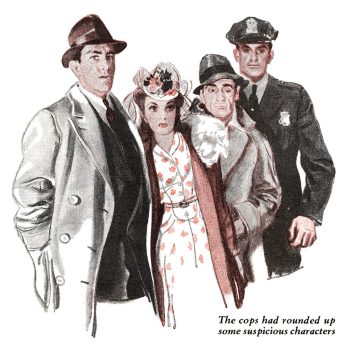 Hewitt gives Wolfe a couple lesser plants Wolfe doesn’t want, but accepts, thanking him as if they were ‘just what he asked Santa Clause for.’
Hewitt gives Wolfe a couple lesser plants Wolfe doesn’t want, but accepts, thanking him as if they were ‘just what he asked Santa Clause for.’
Wolfe carries them himself, which tells you the extremes of sucking up which he’s going to. It’s funny when later Wolfe wants to dump them on Archie, but the latter evades the task and Wolfe is stuck carrying them. Physical exertion is not an activity he enjoys.
Archie says he’d like to give Wolfe a kick in the fundament, which would be an amazing thing to see actually happen. He certainly couldn’t miss!
Hewitt misplaces his walking stick, which Archie says makes Wolfe’s best Malacca one look like a fishing pole. When it’s found, Wolfe tells Archie to pick it up for Hewitt. Archie doesn’t want to cause a scene, so he resists the urge to resign on the spot. Archie picking up the cane is germane to the story.
This just isn’t Wolfe being pleasant, hoping for the best. He is in full-blown sycophant mode. Archie rarely conveys so much disgust and derision with Wolfe. It’s usually an observation -here it’s an ongoing feeling of disgust, which he expresses openly in his narration.
‘And Wolfe following him like an orderly following a colonel, his hands full of potted plants. It would have been comical if it hadn’t been disgusting.’ Archie has to lead, rather than follow, so he doesn’t have to see it.
Archie discusses the body after this, and the story shifts gears. Wolfe goes from toady to (sort of) blackmailer, with a crime to be solved. But it’s fun reading Archie’s open disgust with Wolfe sucking up (poorly) to Hewitt, to try and secure one of the black orchids.
TWO – Archie Goads Wolfe
I really enjoy chapter one of this story. It starts with Archie recounting that Wolfe has sent him to the Flower Show the past three days, to scout out the black orchids. Returning to the office late on day three, he drops “I’m thinking of getting married.”
He talks about the woman in the display, and Wolfe reveals info he has about her, from a story in the newspaper. Archie fatuously argues her virtues with Wolfe (you know Wolfe is unengaged in this discussion), creating a non-discussion discussion.
Having started with this tactic, he elevates it by telling Wolfe that Lewis Hewitt takes her out to dinner. Archie has scored a hit. Wolfe opens his eyes and scowls (See number One).
Wolfe had said that Anne’s legs are too long (in the newspaper picture). Archie, going over the top, puts his leg foot on the desk, lifts his trouser leg up, and tells Wolfe to imagine the result of his cross-pollinating with Anne’s leg. This is silly, but it’s funny. Wolfe tells him not to scar the desk and instructs him to return for a fourth consecutive day.
However, Archie has ratcheted up Wolfe’s desire for the orchids. At lunch, he instructs Archie to get the car – he must “look at those confounded freaks myself.”
Archie had fun goading Wolfe, and he even convinced him to make a sojourn out among a crowd of flower-lovers. If you’ve read “Disguise for Murder”, you know Wolfe’s opinion of the common flower person, as opposed to serious growers like himself.
Chapter one is only six percent of the story’s length, but the reader immediately likes Archie. Wolfe isn’t despicable, like he is in chapter one of “Easter Parade.” But we can see that envy is one of his vices. I think that the best stories often have a strong first chapter. Stout engages us with Archie and Wolfe, right from the start. Of course, middles and endings matter. But I am always happen when I really like the opening chapter, and I’m ready to dive into the rest of the story. I think that the opening in “Black Orchids” shines.
THREE – What Wolfe Wants, Wolfe Gets
Now, I think Wolfe is a jerk to Hewitt in this, and I often find him to be an unlikable person. Not someone I want my son to emulate. I’d like to see Wolfe lose sometimes, based on how he acts.
But he sure knows how to get what he wants. His continual sucking up to Hewitt failed miserably. Hewitt is not going to sell him one of the orchids. He’s certainly not going to just give him one. His kowtowing so repulses Archie, that he can’t even stand to look at Wolfe.
But the moment he has leverage over Hewitt, he sticks the knife in. Hewitt abhors the publicity that he might receive if it becomes known his cane was used for the murder. He could even be a suspect. And Wolfe has him right where he wants him.
For a friend like Marko Vukcic, he would help out for free. He might just soak a normal client – his fees are high. But Hewitt has something he wants. Desperately. It’s a douche move to demand ALL three black orchids, to solve the case. One, or even two, would be more appropriate. But Wolfe is brutal and greedy. Hewitt would have none to develop more from.
Hewitt pretty much goes through the five stages of grief. Wolfe is content to toss Hewitt to Inspector Cramer (there’s no proof that Hewitt did it – it’s an image issue for the rich man). Wolfe refuses to haggle, demands all three. He even insists on taking them immediately before even working on the case.
The Corpus is replete with Wolfe holding out on the police, and using his position and skills to maximize his return. And, as in Easter Parade, being not-admirable, to get what he wants. The recipe for
As I said, I wish he had gotten his nose pushed in a few times. But in this case, he went from a completely losing position, with no standing at all, to getting what he wanted, with payment in advance. Wolfe is tough to beat, in multiple ways.
ONE BAD REASONLike a Hole in Your Head…
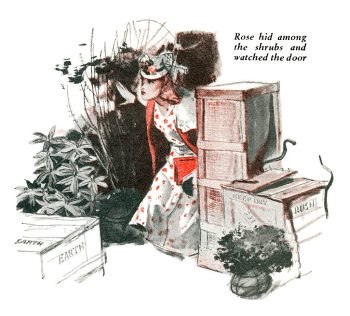 This section was going to be titled ‘With Friends Like These…’ and I was going to talk about what a jerk Wolfe is to Hewitt, to get him out of potential trouble. But as I mentioned above, it’s not clear yet that the two are friends. They are fellow flower growers, and as acquaintances, they get along. But if they had been friends at this point, then Wolfe would have been a miserable one, because of the price he demanded to solve the case. Not how you treat a friend.
This section was going to be titled ‘With Friends Like These…’ and I was going to talk about what a jerk Wolfe is to Hewitt, to get him out of potential trouble. But as I mentioned above, it’s not clear yet that the two are friends. They are fellow flower growers, and as acquaintances, they get along. But if they had been friends at this point, then Wolfe would have been a miserable one, because of the price he demanded to solve the case. Not how you treat a friend.
However, since they aren’t obviously friends yet, I’ll go with Archie’s discovery of the body. It’s a short bit, but I’d NEVER do what he did. And after I did it, no way I could be so blase and low key about it. I’d quite possibly vomit on the spot.
‘On account of the shrubs and rocks, I couldn’t get around to see the top of his head. So I reached a hand to feel of it. And the end of my finger went right through into a hole in his skull. A way in. And it was like sticking your finger into a warm apple pie. I pulled away and started wiping my finger off on the grass.’
Man, I don’t even wanna eat apple pie (which I love) after reading this! I’m squeamish. I hate watching autopsy stuff in crime shows. The thought of (even unexpectedly) sticking my finger in a hole in somebody’s skull and going down into their brain? I’m squirming, just typing it right now.
And to calmly pull it out and begin wiping blood and brain off on the grass, showing no trace of what was going on? NO WAY!
“Black Orchids” is one of my favorite novellas, but I hate this part. I’m glad it’s so short, as it is an abrupt chapter end.
MISCELLANEAThe story originally appeared – abridged – in the August, 1941 issue of The American Magazine under the title, “Death Wears an Orchid.” Which is not an accurate title for this story…
It would be published with “Cordially Invited to Meet Death” (which was originally called “Invitation to Murder”) in hardcover by Farr & Rinehart the following year.
Stout had written eight Wolfe novels, published over the previous seven years. Black Orchid was the first novella or short story.
There are no definitive definitions, and the acceptable length of a novel has grown over the years (look at the length of early books in some of your favorite series’, and see them get longer. Lawrence Block’s Matthew Scudder is a good example). We’ll go with:
Short Story – Up to 15,000 words
Novella – 15,000 – 50,000 words
Novel – Over 50,000 words
At around 34,000 words, Black Orchids was much shorter than his earlier novels. However it is about twice as long as “Cordially Invited to Meet Death”, which followed eight months later. I much prefer the shorter form for Wolfe and Archie, and am glad Stout began writing novellas, instead of novels. This allowed him to sell the stories to magazines (including better paying ‘Slicks), and then bundle two or three together for a hardcover book.
This story features a rare, two-paragraph intro by Archie: Archie does not introduce his recountings. He mentions speculation on how ‘Nero Wolfe got hold of the three black orchids.’ The first tale in this book explains how that happened as a result of a murder. The second explains how some black orchids appeared at a funeral: and it involves a mystery that is still biting Archie.
Archie comments that the women who attend flower shows are not very attractive. He would repeat this thought nine years later at the Brownstone, in “Disguise for Murder.”
Archie being Archie, he manages to find one rose in a field of weeds. But it is clear he will not be attending flower shows to look for dates.
The Bantam intro is written by Lawrence Block. Block relates how, trying to figure out where to go with his third Chip Harrison novel. As he puts it, ‘Inspiration struck’ and he converted Harrison into an Archie Goodwin, working for Leo Haig – a poor man’s Nero Wolfe. Haig is a low-end private eye whose life goal is to be invited to dinner at Wolfe’s table – Wolfe being a real person. I enjoy the two Haig novels, and wrote an essay titled The R-Rated Nero Wolfe for award-winning website, BlackGate.com.
YOU DON’T SAYArchie – “Will you kindly tell me,” I requested, “why the females you see at a flower show, are the kinds of females who go to a flower show? 90% of them. Especially their legs. Does it have to be like that? Is it because, never having any flowers sent to them, they have to go to see any? Or is it because -”
Wolfe – “Shut up. I don’t know.”
Wolfe – “Where are you going?”
Hewitt – “The water nymph. The pool episode. I thought you might-”
Wolfe – “Bosch. That bedlam.”
Hewitt – “It’s really worth seeing. Charming. Perfectly Charming. Really delightful.”
Wolfe – “I’ll come too.”
Hewittt – “I see” – he hissed. “So that’s it. To put it plainly, blackmail. Blackmail. No, I won’t do it.”
Wolfe – He sighed. “You won’t?”
Hewitt – “No.”
Wolfe – “Very well. Then I won’t get the orchids. But I’ll be saved a lot of trouble. Archie, get Mr. Cramer in here. Tell him it’s urgent.”
Stay at Home
Nero Wolfe’s Brownstone: Stay at Home – Days 1 and 2
Nero Wolfe’s Brownstone: Stay at Home- Days 3 and 4
Nero Wolfe’s Brownstone: Stay at Home- Days 5, 6, and 7
Nero Wolfe’s Brownstone: Stay at Home- Days 8, 9, and 10
Nero Wolfe’s Brownstone: Stay at Home- Days 11, 12, and 13
Nero Wolfe’s Brownstone: Stay at Home Days 14 and 15
 Nero Wolfe’s Brownstone: Stay at Home Days 16 and 17
Nero Wolfe’s Brownstone: Stay at Home Days 16 and 17
Nero Wolfe’s Browsnstone: Stay at Home – Days 18 and 19
Nero Wolfe’s Brownstone: Stay at Home – Days 20 and 21
Nero Wolfe’s Brownstone: Stay at Home – Days 22 and 23
Nero Wolfe’s Brownstone: Stay at Home – Days 24 and 25
Nero Wolfe’s Brownstone: Stay at Home – Day 26
Nero Wolfe’s Brownstone: Stay at Home – Day 27
Nero Wolfe’s Brownstone: Stay at Home – Days 28 and 29
Nero Wolfe’s Brownstone: Stay at Home – Day 30
Nero Wolfe’s Brownstone: Stay at Home – Day 31
Nero Wolfe’s Brownstone: Stay at Home – Days 32 and 33
Nero Wolfe’s Brownstone: Stay at Home – Days 34 and 35
Nero Wolfe’s Brownstone: Stay at Home – Day 36
Nero Wolfe’s Brownstone: Stay at Home – Day 37
Nero Wolfe’s Brownstone: Stay at Home – Day 38
Nero Wolfe’s Brownstone: Stay at Home – Day 39
Nero Wolfe’s Brownstone: Stay at Home – Days 40 & 41
Nero Wolfe’s Brownstone: Stay at Home – Days 42 & 43
Nero Wolfe’s Brownstone: Stay at Home – Days 45 & 46
Nero Wolfe’s Brownstone: Stay at Home – Days 50 and 52
Nero Wolfe’s Brownstone: Stay at Home – Day 55
Nero Wolfe’s Brownstone
Meet Nero Wolfe
The R-Rated Nero Wolfe
Radio & Screen Wolfe
A&E’s ‘A Nero Wolfe Mystery’
The Lost 1959 Pilot
The Mets in “Please Pass the Guilt”
A Matter of Identity (original story)
Death of a Doxy; and Koufax or Mays?
Hercule Poirot Visits Nero Wolfe
I Know that Actor!
The Big Store (Wolf J. Flywheel)
Welcome to Kanawha Spa – The Wolfe Pack 2024 Greenbrier Weekend
A Toast To Nero Wolfe – From the Wolfe Pack 2024 Greenbrier Weekend
3 Good Reasons
3 Good Reasons – ‘Not Quite Dead Enough’
3 Good Reasons – ‘Murder is Corny’
3 Good Reasons – ‘Immune to Murder’
3 Good Reason – ‘Booby Trap’
The Greenstreet Chronicles (Pastiches based on the Radio Show)
The Careworn Cuff – Part One
The Careworn Cuff – Part Two
The Careworn Cuff – Part Three

Bob Byrne’s ‘A (Black) Gat in the Hand’ made its Black Gate debut in 2018 and has returned every summer since.
His ‘The Public Life of Sherlock Holmes’ column ran every Monday morning at Black Gate from March, 2014 through March, 2017. And he irregularly posts on Rex Stout’s gargantuan detective in ‘Nero Wolfe’s Brownstone.’ He is a member of the Praed Street Irregulars, founded www.SolarPons.com (the only website dedicated to the ‘Sherlock Holmes of Praed Street’).
He organized Black Gate’s award-nominated ‘Discovering Robert E. Howard’ series, as well as the award-winning ‘Hither Came Conan’ series. Which is now part of THE Definitive guide to Conan. He also organized 2023’s ‘Talking Tolkien.’
He has contributed stories to The MX Book of New Sherlock Holmes Stories — Parts III, IV, V, VI, XXI, and XXXIII.
He has written introductions for Steeger Books, and appeared in several magazines, including Black Mask, Sherlock Holmes Mystery Magazine, The Strand Magazine, and Sherlock Magazine.
You can definitely ‘experience the Bobness’ at Jason Waltz’s ’24? in 42′ podcast.
Audiobook Review: The Haunting of Room 904 by Erika T. Wurth
I received a review copy from the publisher. This does not affect the contents of my review and all opinions are my own.
 The Haunting of Room 904 by Erika T. Wurth
The Haunting of Room 904 by Erika T. Wurth
Mogsy’s Rating (Overall): 1.5 of 5 stars
Genre: Horror, Mystery
Series: Stand Alone
Publisher: Macmillan Audio (March 18, 2025)
Length: 9 hrs and 48 mins
Author Information: Website
At first, I was very excited to pick up The Haunting of Room 904. I mean, come on! Even the title sounded awesome. What could possibly go wrong with the promise of a haunted hotel story? Well, apparently, quite a whole lot. And when I looked up the author’s information, I was actually surprised to find out that this was not Erika T. Wurth’s first novel, because both the writing and plotting felt amateurish in a disjointed, sloppy way, which unfortunately kept the novel from ever fully realizing its ambitious premise.
The story follows Olivia Becente, a struggling academic who has turned to capitalizing on her clairvoyant gifts to make ends meet. Now a paranormal investigator, she works with clients who hire her to commune with the dead and occasionally takes on cases that involve neutralizing the dangerous effects of haunted or possessed items. But the truth is, Olivia has a pretty haunted history herself. Ever since the unexpected suicide of her sister Naiche, Olivia can’t stop thinking about her or any of unexplainable circumstances around how she died.
This is why, years later, when she is contacted by the Brown Palace hotel about a new case, Olivia immediately agrees to investigate. Not only is it one of the most recognizable landmarks in Denver, but the hotel is also the one in which Naiche killed herself in Room 904. It comes to light that every five years, a woman mysteriously dies in that room, no matter what the hotel does to prevent it from happening, even sealing it off altogether. As Olivia and her friends try to make sense of these connections, she receives a disturbing call from her mother, sounding distressed and confused, revealing that she has somehow checked into Room 904—despite having no recollection of how she got there. Now racing against the clock, Olivia’s investigation brings her to confront everything from a secret cult to the mysteries of an ancient power.
It honestly annoys me whenever a book with an amazing premise manages to completely unravel under the weight of its own ambition. It’s a shame because The Haunting of Room 904 could have been great, but what we get instead is an overstuffed narrative with simply too much happening at once. Rather than having things unfold naturally, the novel stumbles from one subplot to another like an easily distracted toddler. Things start off smoothly with Olivia’s investigation into a haunting but they quickly devolve from there, shifting suddenly to her family problems, then to her dealing with a stalker ex, and out of the blue a romantic development gets thrown in as well. There’s enough silly drama here to fill ten books, but instead everything is crammed together in a way that leaves everything feeling half-baked.
On top of that, the protagonist Olivia is the worst kind of idiot, someone who is constantly positioning herself as the smartest person in the room, yet her decisions contradict that perception at every turn. In one egregious example, she moralizes about guns only to justify getting a concealed carry permit because she believes her situation is unique, yet fails to arm herself when it critically mattered, resulting in the gun being turned on her by the very person she wanted to protect herself from—all because she set a glaringly obvious passcode on her safe. She’s also unbearably judgmental of others yet blind to her own flaws, making her difficult to root for. Partly, I think this in part is due to the book seeming more concerned with checking identity boxes and inserting social commentary than telling a compelling story. For example, every character’s race, gender, background, disability, etc. is noted, even when it’s completely irrelevant to the plot. The dialogue suffers greatly because of this too, because no one really talks the way these characters do. In some of their interactions, rather than an organic conversation, they come across more like stilted, overly self-aware message pushing instead.
Then there’s the matter of character development—or lack thereof. Olivia’s friends are little more than stock archetypes, defined by their identity labels above and further slotted into cookie cutter type caricatures: Genius Loudmouth Friend A, Sensitive Supportive Friend B, etc. And obviously, we mustn’t forget the dastardly ex-boyfriend who is cartoonishly villainous. But of course, Olivia being Olivia, she immediately gets the googly eyes for the next man who gives her attention, never mind that he’s a suspiciously charismatic leader of a fucking cult! Remember though, Olivia isn’t too bright, and the fact the guy is hot and fits the dark, broody goth aesthetic means that he gets a pass.
As if the disjointed plot and shallow characters weren’t bad enough, the writing itself is a hot mess. Transitions between events are choppy, making it a pain to follow the story. The pacing is also all over the place. The horror elements, which should have been at the forefront, feel tacked on and underdeveloped. What could have been an intense, mysterious, and atmospheric ghost story instead reads like a bland, dime-store thriller with some paranormal elements hastily sprinkled in. Any sense of suspense or dread is completely lost.
Ultimately, The Haunting of Room 904 is a book that had all the ingredients (one might even argue too many ingredients) for a creepy and engaging horror novel with some thriller elements mixed in. However, the failure to pull all these pieces together in a cohesive and coherent manner resulted in a disappointing read where the core mystery lacked direction and focus in its execution. Sadly, the book started out strong, but by the end, it simply fell apart under the weight of all its missteps.
![]()
![]()
Upcoming News: Fae: The Wild Hunt - 10th Anniversary Special Edition by Graham Austin-King

Tomorrow is the launch of Graham Austin-King's Fae: The Wild Hunt Kickstarter. This is in celebration of the tenth anniversary of Fae: The Wild Hunt's publication. Here's the blurb for the book:
History becomes legend.Legend fades to myth.But some myths are a warning.
Klöss wants nothing more than to pass the trials and join the ranks of the Bjornmen raiders. But times are changing in the Barren Isles. Coastal plunder is making way for outright conquest, and war looms.
A foundling from the forest, Devin leads a simple life. But fate, it seems, has other plans. Whispered rumours tell of creatures in the moonlight, shadowy figures with eyes of amber flame. As the first battles rage, only one man seems to know the truth of the fae, but can Devin or Klöss convince anyone before it is too late?
The cover artwork is by Tomasz Jedruszek.

The cover and sprayed edge design is by the amazing Rachael St Clair of Claymore Covers. This edition will also sprayed edges, foiled hardboards, colour endpapers, refreshed cartography, custom chapter art & of course all copies will be signed by the author
Fae: The Wild Hunt is the first book of The Riven Wyrde Saga, a complete trilogy where the mythologised fae return to a world which has forgotten them. And as the barriers protecting the world of Haven begin to falter, Bjornmen raiders abandon coastal plunder for outright conquest. This Kickstarter, the first of three, aims to change that, with fresh cover art and a stunning special edition hardcover.
Make Readers Buy Your Next Book
I’ll tell you how in the second workshop in the Quick & Dirty Craft Series.
There are some simple things every writer can do to make their endings stronger, and I’ll explain that in this short class.
Find out more here or watch the video below.
https://kriswrites.com/wp-content/uploads/2025/03/QD-ENDINGS-INTRO-ORIGINAL-VIDEO.mp4
Across Time: Claude Moreau and His Translator Scott Oden in Conversation
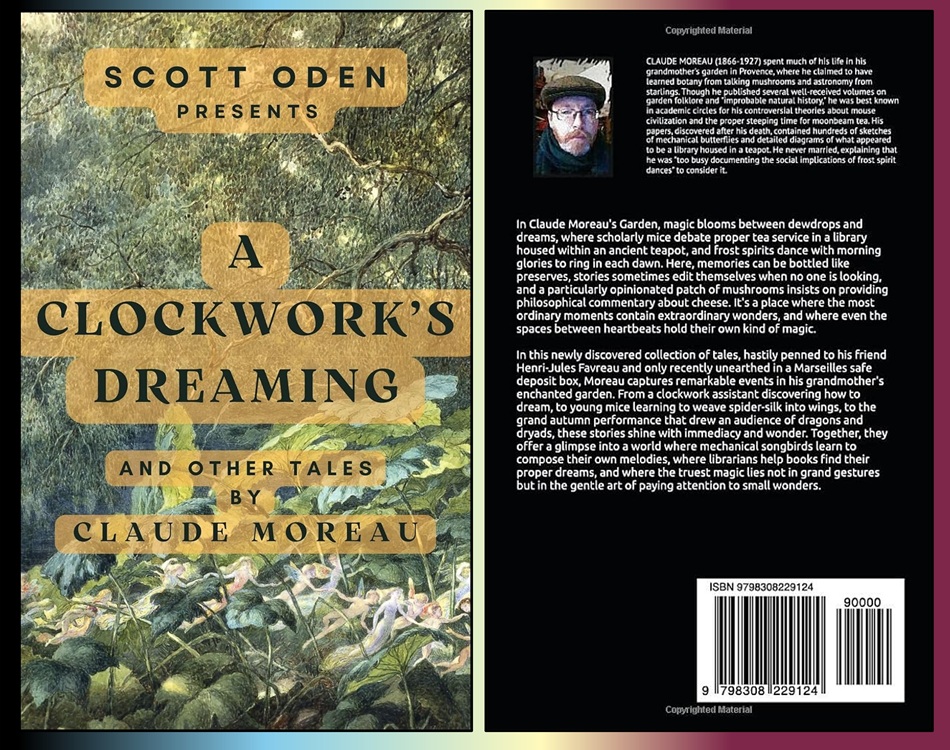 A Clockwork’s Dreaming: And Other Tales by Claude Moreau [Claude Moreau and Scott Oden, Jan 24, 2025, 134pages, Kindle and Paperback]. Cover art by Richard Doyle. Detail from “Under the Dock Leaves: An Autumnal Evening Dream” (1878).
This post packs two punches:
A Clockwork’s Dreaming: And Other Tales by Claude Moreau [Claude Moreau and Scott Oden, Jan 24, 2025, 134pages, Kindle and Paperback]. Cover art by Richard Doyle. Detail from “Under the Dock Leaves: An Autumnal Evening Dream” (1878).
This post packs two punches:
- A showcase of the New Treasure A Clockwork’s Dreaming: And Other Tales by Claude Moreau and Scott Oden (January 2025, 134 pages, Kindle and Paperback).
- An exclusive interview with the deceased author Claude Moreau, the living translator Scott Oden, and special appearances of Laurent Dupont, editor of the literary magazine Les Petites Merveilles. Yes, this article is historic and magical. Read on to learn how this came to be.
“In Claude Moreau’s Garden, magic blooms between dewdrops and dreams, where scholarly mice debate proper tea service in a library housed within an ancient teapot, and frost spirits dance with morning glories to ring in each dawn. Here, memories can be bottled like preserves, stories sometimes edit themselves when no one is looking, and a particularly opinionated patch of mushrooms insists on providing philosophical commentary about cheese. It’s a place where the most ordinary moments contain extraordinary wonders, and where even the spaces between heartbeats hold their own kind of magic.
In this newly discovered collection of tales, hastily penned to his friend Henri-Jules Favreau and only recently unearthed in a Marseilles safe deposit box, Moreau captures remarkable events in his grandmother’s enchanted garden. From a clockwork assistant discovering how to dream, to young mice learning to weave spider-silk into wings, to the grand autumn performance that drew an audience of dragons and dryads, these stories shine with immediacy and wonder. Together, they offer a glimpse into a world where mechanical songbirds learn to compose their own melodies, where librarians help books find their proper dreams, and where the truest magic lies not in grand gestures but in the gentle art of paying attention to small wonders.” – Cover Summary
Oden just released A Clockwork’s Dreaming: And Other Tales (January 2025). The content holds remarkably true to his adventure telling and love of historical fiction, but is completely different than his grimdark portfolio. Oden shifted toward inspirational, non-grim fiction with this. There are six stories plus pre and post-commentary. All stories are easily digestible. The introductory premise resonates with the weird fiction vibe having the narrator/translator deciphering letters from deceased scientists/gardeners who experienced the supernatural. Instead of the experience being horrific, these are all uplifting. The initial tales calibrate the reader to a world reminiscent of C.S. Lewis’s Narnia (i.e. talking creatures). Readers should expect anthropomorphized mice and trees, heck, even “stories” become sentient and assume tangible substance. Terms like “astronomical gardening” and situations like “books were talking about feeling colorless” saturate this wonderful collection.
“The Maples’ Grand Performance” story mesmerized me until I cheered for the finale. Next, a homage to Lord Byron’s “Ozymandias” poem showcased a heroic mouse of the same name tackling greed and achieving a legacy; this swelled me with optimism. The titular tale “Clockwork’s Dreaming” at first evoked, at least for my Gen X mind, the owl Bubo from the 1981 Clash of the Titans, since it involves a mechanical bird. Oden’s character is actually a fun protagonist (not a goofy sidekick). After you read the book, you’ll be compelled to dig into Claude Moreau’s Garden website which has many complementary tales.
With A Clockwork’s Dreaming, Oden inspires readers via tall tales featuring heroic mice. Oden’s prose impacts as much as his grimdark tales, but smacks with beauty and peace! An Exclusive Interview with Moreau, Oden, and DupontIn January 2025, while researching in the rarely-accessed archives beneath Black Gate headquarters, I discovered a cache of remarkable documents, fragments of an 1899 interview with Claude Moreau conducted by Laurent Dupont, editor of the literary magazine Les Petites Merveilles. The fragile pages were nestled between volumes of obscure grimoires and games of strategy, and appeared to shift location between visits to the archive. It is unclear if John O’Neill knew he had these documents since they were uncharacteristically absent from his meticulous card catalog.
Even more remarkably, these historical fragments seem to resonate with the questions for Scott Oden, translator of Moreau’s recently discovered works and longtime friend/contributor with Black Gate. What follows is an unprecedented conversation across time: Moreau’s words from 1899 alongside his translator’s reflections in 2025. Where the original document was damaged or illegible, we rely solely on Oden’s modern perspective.
The original document is reproduced with permission from the private collection of John O’Neill.
Across Time: Claude Moreau and His Translator Scott Oden in Conversation On the Nature of Moreau’s WorkBLACK GATE (2025): As per the prologue to A Clockwork’s Dreaming, you “discovered a remarkable collection of letters, pressed flowers, and curious objects that can only be described as fairy wings and dragon scales. The correspondence was from Claude Moreau to his friend Henri-Jules Favreau, written between 1897 and 1898.” Please introduce newcomers to Moreau’s works. What should they expect?
ODEN (2025): Claude Moreau was an Impressionist painter who, after a rather disastrous exhibition in Paris (the notorious ‘Incident of the Purple Cats’), retreated to his grandmother’s cottage in rural Provence. There, while attempting to document the garden’s more conventional aspects, he began noticing… unusual activities. His letters to Henri-Jules Favreau, a professor of Improbable Literature at the University of Aix-en-Provence, chronicle an entire hidden world within his grandmother’s garden — a place where mice maintain libraries in forgotten teapots, where mechanical creations dream of becoming more than their gears, and where memories can be preserved in specially crafted jars.
Readers should expect stories that exist in the space between wonder and reality — tales that don’t shy away from life’s shadows but find beauty and courage in gentleness rather than conflict. These aren’t simply children’s stories, though children often grasp their truth more readily than adults. They’re accounts of a world that operates according to different rules than our own, yet somehow illuminates truths about our reality. Unlike my usual historical fiction or the adventures of Grimnir, the Garden tales offer a different kind of magic — the extraordinary possibilities hiding within ordinary moments.
DUPONT (1899): Monsieur Moreau, your tales of life in your grandmother’s garden have caused quite a stir among our readers. Many write to ask if these stories are meant to be taken as fact or fancy. How would you respond?
MOREAU (1899): My dear Dupont, I find such distinctions increasingly tiresome. Is a sunset less beautiful if one understands the scientific principles behind refracted light? Does knowing the Latin name for a flower diminish its scent? I simply record what I observe in my grandmother’s garden, with as much accuracy as my humble talents allow. Whether readers choose to see these observations as literal or metaphorical matters less than whether they recognize some small truth within them.
DUPONT (1899): Yet you speak of talking mice, singing flowers, and mechanical devices that develop consciousness. Surely you understand why readers might question—
MOREAU (1899): I understand perfectly why people raised on the rigid categorizations of modern thought might struggle. We are taught from an early age to separate the world into neat compartments: reality and fantasy, science and magic, fact and fiction. But the Garden exists in the spaces between such artificial boundaries. The mice don’t “talk” as you and I are doing now—they communicate in ways that require a different kind of listening altogether. As for mechanical consciousness, well… [pauses to sip tea] Have you never observed how certain objects seem to develop personalities over time? How a well-loved book begins to open naturally to its owner’s favorite passages? Or how a clockwork mechanism that has run for decades seems to develop its own subtle rhythms beyond mere mechanical precision?
On Literary ConnectionsIn 1896 Claude Moreau’s contemporary H. G. Wells published The Island of Doctor Moreau; is there a relationship between these scientifically curious Moreaus?
What an intriguing coincidence! Though I’ve found no direct evidence that Claude Moreau and H.G. Wells ever met, there’s a certain synchronicity in their work appearing around the same time. Both dealt with boundaries between the natural and unnatural, though in radically different ways.
Where Dr. Moreau attempted to force nature into unnatural forms through scientific hubris, Claude Moreau documented the quiet magic that emerges when nature is allowed to follow its own extraordinary course. One sought to control and transform; the other simply observed with careful attention and wonder.
I sometimes imagine them encountering each other at some Parisian café — Wells with his scientific skepticism and Claude with his dreamer’s heart — engaging in a spirited debate about the boundaries between reality and fantasy. What a conversation that would have been!
DUPONT (1899): Several critics have suggested your tales are simply allegories — clever ways of discussing human relationships through the filter of imagined garden creatures.
MOREAU (1899): [laughs] Critics will always seek to explain mystery rather than simply experience it. Perhaps there is something allegorical in my accounts. The Garden certainly has much to teach us about human nature. But to reduce these stories to mere invention would be to miss their essential truth. The Garden exists, Monsieur Dupont. Whether one can find it on any conventional map is beside the point.
On The Garden’s LibrariesMoreau’s Gardens appear to be sprawling, like a Botanical Garden complex with many subgardens. The quote below indicates the subgardens are ‘libraries.’ How many flavors of libraries & gardens exist?
“There are libraries that exist beyond the knowledge of most garden visitors — collections not of books but of potential and promise, cataloged with a precision that would impress even Mr. Thistledown himself.” From the Seed Librarians
As chronicled in Moreau’s letters, the Garden contains numerous libraries beyond the main one housed in the teapot. The Library proper primarily holds stories and knowledge in traditional book form (though ‘traditional’ may be stretching it, given that some volumes reportedly change their contents depending on the phase of the moon).
But yes, there are specialized collections throughout the Garden. The Seed Library maintains living knowledge of plant species both common and forgotten, preserving not just physical seeds but the stories and songs that help them grow. The Memory Archives, maintained by Grandmother Elderberry and her apprentices, preserve experiences in specially crafted jars. The Frost Spirits maintain crystalline records of winter patterns dating back centuries, while the underground chambers beneath the Old Stone Wall house historical artifacts too delicate for conventional preservation.
Each ‘library’ serves as a repository for different types of knowledge, operating according to principles uniquely suited to what they preserve. The Seed Librarians, for instance, understand that some knowledge must be planted rather than simply shelved; allowed to grow and change with the seasons rather than remaining static.
DUPONT (1899): Speaking of the Garden, many readers have written asking about its precise location. Is it somewhere they might visit?
MOREAU (1899): [laughs] The Garden exists precisely where it needs to be. Those who seek it with open hearts occasionally find their way there, though rarely by any conventional path. I’ve noticed that children often discover it without difficulty, while adults struggle — particularly those who approach life with rigid certainty about what is and isn’t possible.
But perhaps I can offer this small hint: the Garden is most accessible during those in-between moments when the world holds its breath. Dawn and dusk. The precise instant between sleeping and waking. The day’s last moment before starlight claims dominion. In such moments, boundaries thin, and careful observers might glimpse the Library’s lamplight glowing through the mist, or hear the Cricket Orchestra tuning their instruments for the evening concert.
[The next portion of the original document is damaged, with several paragraphs illegible due to what appears to be tea stains and pressed flower residue.]
On the Black Gate ArchivesThese notes that I dug up from the basement Library of O’Neill must contain secrets. In other words, via this interview, I claim that O’Neill’s basement is a magical Garden. Can you read the grimoires, and reveal a secret here, just for devoted Black Gate readers?
What extraordinary documents you’ve uncovered! These look remarkably similar to some pages I found in that Marseilles safe deposit box — particularly this one with the strange watermark that appears to change depending on the angle of light.
If I’m translating the mouse-script correctly (it’s a particularly archaic dialect), this seems to be part of a correspondence between Mr. Thistledown and the librarian of what he calls ‘The Other Garden.’ Fascinating! According to these notes, certain gardens develop what he terms ‘mutual literary resonance’ when their caretakers share a particular quality of imagination.
The text specifically mentions a ‘Keeper O’Neill’ whose collection of strange and wondrous tales created a bridge between his garden and Moreau’s. There’s a reference here to something called ‘The Device’ — apparently some kind of mechanical contraption that helped stories travel between the two spaces. How remarkable!
And this diagram in the corner… if I’m not mistaken, it’s showing the precise arrangement of books required to create a gateway between gardens. One shelf must contain tales of wonder; another, histories both true and imagined; a third, poetry that reveals the extraordinary within the ordinary. When arranged correctly and illuminated by the proper quality of lamplight, they supposedly create a passage through which stories can migrate.
What an extraordinary discovery! I’d be most interested in studying these documents further. Perhaps there are other gardens similarly connected that we’ve yet to discover . . .
MOREAU (1899): [From a fragment discovered pressed between the pages of an unrelated manuscript] . . . most fascinating correspondence from an English gentleman collector who maintains what he calls a “repository of improbable narratives.” He claims to have discovered a method whereby stories can travel between sympathetic gardens — a kind of literary pollination that transcends conventional boundaries of time and space. His description of mechanical assistance in this process reminds me somewhat of Uncle Rowan’s work, though applied to purposes I never considered . . .
[The fragment ends here, the remainder apparently lost.]
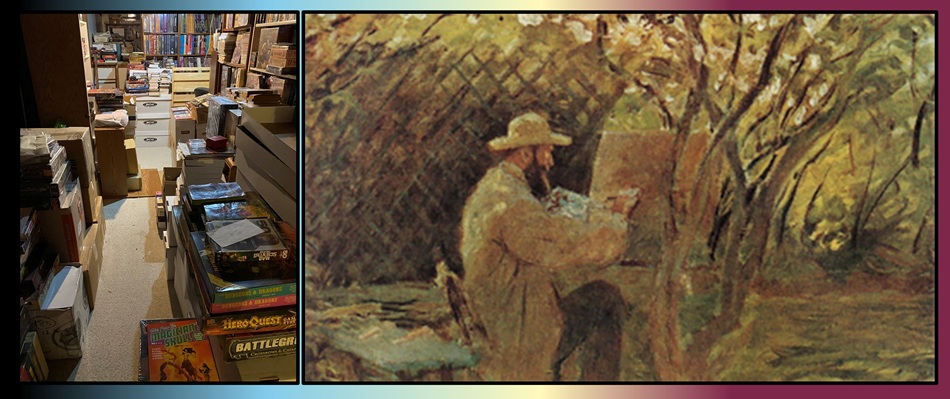 (Left) Photo Credits: John O’Neill of his own secret, sacred Garden of Inspiration, aka Black Archives, 2025. (Right) The “other” Claude… Claude Monet, who was also a lover of magical gardens
On Beauty
(Left) Photo Credits: John O’Neill of his own secret, sacred Garden of Inspiration, aka Black Archives, 2025. (Right) The “other” Claude… Claude Monet, who was also a lover of magical gardens
On Beauty
The mechanical songbird Assistant [from the titular tale “Clockwork’s Dreaming”] wants answers. It found Mr. Thistledown’s theoretical texts too confusing, so we ask you: What is beauty?
The Assistant posed this very question to Mr. Thistledown, who produced a seventeen-page theoretical treatise that only confused matters further. Miss Hazel offered a more concise answer that I think captures the Garden’s perspective beautifully.
‘Beauty,’ she said, ‘is what happens when attention meets wonder.’
She explained that beauty isn’t merely an attribute of certain objects or moments, but emerges in the relationship between observer and observed. It requires both the thing being seen and the quality of seeing. A dewdrop on a spider’s web might contain extraordinary beauty, but only reveals it to those who pause long enough to truly look.
The Garden understands beauty as a conversation, not a fixed quality but a living exchange. The morning glories’ music sounds more beautiful when listened to with appreciation; the library’s books reveal deeper magic when approached with genuine curiosity.
Perhaps that’s why beauty often feels so fleeting and personal. It doesn’t exist separately from our perception but emerges precisely in that delicate moment when we give something our complete attention and it responds by revealing its true nature. Beauty happens in the spaces between — between looking and seeing, between hearing and listening, between knowing and understanding.
DUPONT (1899): Your work seems quite different from the prevailing literary trends. While naturalism and psychological realism dominate Parisian literary salons, you write of frost spirits dancing on windowsills and libraries housed in teapots. What influences have shaped your unusual perspective?
MOREAU (1899): My grandmother, first and foremost. She was a remarkable woman who understood that reality is far more permeable than most people realize. She taught me to look at the world not just with my eyes, but with my heart — to see the spaces between things, where the most interesting possibilities reside.
Beyond that, I find inspiration in the countless small wonders that most overlook: the precise geometry of dewdrops on a spider’s web at dawn, the way certain shadows seem to move independently of their casters, the subtle changes in the Garden’s mood as seasons shift. I’ve also developed a deep appreciation for what the mice call “the music of small moments” — those quiet intervals where nothing dramatic occurs, yet everything somehow changes.
As for literary influences . . . [thoughtful pause] I’ve always been drawn to works that recognize the extraordinary possibilities hiding within ordinary existence. The folk tales my grandmother told me as a child. The poetry of Wordsworth and Shelley. Even certain scientific texts that, read with the proper frame of mind, reveal wonders beyond their authors’ intentions.
[Translator’s note: It’s remarkable how Moreau’s understanding of beauty as residing in the quality of attention anticipates Miss Hazel’s later articulation of this principle. The Garden’s approach to beauty seems to have remained consistent across generations of its inhabitants.]
On Magical CraftingGrandmother Elderberry’s Notebooks indicates that emotions are a colorful artistic media (quote below). How does one craft with magical media?
Among the most precious memories to gather during seasonal transition is what I call “the color of hope”—that particular shade of green that exists only in the earliest days of spring. Not the vibrant certainty of full-season growth, but the gentle, hesitant green of possibility testing itself… This color cannot be properly seen with ordinary vision. One must develop the habit of looking slightly to the side of what one wishes to observe, catching it in peripheral awareness where the eye’s wisdom exceeds its technical capabilities. — From Memory-Keeping in Transition Seasons
Grandmother Elderberry’s techniques for magical crafting emphasize relationship over mere methodology. According to Moreau’s notes, she taught her apprentices to understand that different emotions and memories have distinct qualities that must be honored in how they’re preserved.
The ‘color of hope,’ for instance, requires vessels made from materials that themselves embody possibility: morning dew collected from unfurling leaves, glass blown during the exact moment between night and day, preservation spells that allow for growth rather than mere stasis.
The peripheral vision technique Grandmother mentions is actually documented in several of Moreau’s letters. He describes spending weeks learning to ‘unsee’ in order to truly see, training himself to notice what happens just at the edge of perception. The Garden’s magic often reveals itself in these in-between spaces, visible only when we stop trying to focus directly on it.
For those interested in developing such perception, Grandmother recommended starting with dawn observation. Sit in perfect stillness as night transitions to day, paying attention not to the sun’s dramatic appearance but to the subtle shifts in color and texture that precede it. Don’t look directly at any one thing; instead, allow your awareness to soften and spread. The ‘color of hope’ often appears first as a feeling rather than a visual sensation — a quality of lightness that precedes actual light.
Once perceived, such colors must be captured in containers that respect their nature. Hope cannot be preserved in airtight jars. It needs space to breathe and grow. Memories of joy require vessels that can expand slightly over time, as joy tends to magnify in remembering. Moments of peace should be kept in containers that remain cool regardless of external temperature.
The true magic, according to Grandmother Elderberry, lies not in the technical process but in the relationship — in approaching each emotion and memory with the proper quality of attention and respect.
DUPONT (1899): Some of our more scientifically-minded readers have questioned your accounts of “memory-catching” and the preservation of moments in Grandmother Elderberry’s special jars. Would you care to elaborate on how such things might be possible?
MOREAU (1899): Ah, the eternal “how” question! [chuckles] Your scientific readers approach the world with admirable curiosity, but perhaps slightly misplaced methodology. They seek mechanical explanations for phenomena that operate by entirely different principles.
Grandmother Elderberry’s memory-catching isn’t so much a technique as it is a relationship — a deep understanding of how moments wish to be preserved. Different memories require different methods. The scent of spring rain on lavender requires specially treated glass that breathes with the seasons. The exact color of twilight through autumn leaves must be caught in jars lined with pressed moonflowers. The sound of snow falling on a silent Garden needs vessels woven from spider silk and starlight.
The essential principle, though, is attention. One must observe with such complete presence that the moment recognizes itself in your perception and agrees to be preserved. The mice understand this instinctively, particularly young Primrose, who has inherited her grandmother’s gift. Humans tend to struggle with it, as our minds so often wander to yesterday’s regrets or tomorrow’s anxieties, missing the perfect now that stands ready to be caught.
On Historical LiteratureCan you discuss how historic literature informs Claude’s or your muse? Certainly, in your own writing, there are echoes of Beowulf in the Grimnir saga, and Lord Byron’s poem ‘Ozymandias’ explicitly has a retelling inside A Clockwork’s Dreaming.
The Garden stories reflect a deep conversation with historical literature — both consciously and unconsciously. Moreau was clearly influenced by the Romantic poets, particularly their attention to nature’s small wonders and their belief in the extraordinary possibilities hiding within ordinary reality. There’s something of Blake’s ability to ‘see a world in a grain of sand’ throughout his observations.
The ‘Ozymandias’ retelling represents one of the more direct literary engagements. According to Moreau’s letters, he actually told this tale to Shelley during a chance meeting in Geneva, though the poet naturally transformed it to suit his own artistic vision. The mouse version maintains the poem’s meditation on power and impermanence but adds something uniquely Garden-like — the understanding that true legacy comes not from monuments but from shared growth and knowledge.
As for my own work, yes, the Grimnir saga draws deeply from ancient Norse mythology and the rhythms of Beowulf. Historical literature provides not just settings and characters but fundamental patterns of storytelling that resonate across centuries. The Garden tales, for all their gentleness, engage with these same ancient patterns — journeys of transformation, encounters with the mysterious, the preservation of wisdom against forces of forgetting.
What differs is not the underlying mythic structure but the expression. Where Grimnir’s tale is told in steel and blood and thunder, the Garden stories unfold in dewdrops and whispers and the spaces between heartbeats. Both, in their way, explore similar questions about what endures and what fades, about courage in its many forms, about the search for meaning in a world full of mystery.
DUPONT (1899): [This portion of the manuscript is badly damaged, with only fragments legible] . . . your meetings with other literary figures . . . Mr. Shelley in particular . . . story about Mouse-Kings and ancient power . . .
MOREAU (1899): [From fragments of response] . . . quite by accident, I assure you. We found ourselves sharing lodgings during that dreadful storm. Percy was most attentive, though I cannot claim he transcribed my humble mouse tale with complete fidelity. His poetic sensibilities naturally transformed . . . the essential truth remains, however distorted by human perspective . . . never met Lord Byron personally, though I understand he keeps a rather impressive garden himself . . .
On Art and Dreaming
What does Pip know about being an artist? The bird asked him “Would you teach me [about art]? About seeing beauty in irregular things?” Art is just another way of dreaming out loud. That would indicate that A Clockwork’s Dreaming is actually about Clockwork Art.
Pip’s understanding of art evolved throughout his apprenticeship in the Garden. Initially, he tried to capture beauty using magical materials — bottled starlight, preserved dewdrops, the essence of moonlight — believing that extraordinary subjects required extraordinary techniques.
What Claude taught him (and what the mechanical creatures came to understand) is that art isn’t about the materials but about the relationship between observer and observed. ‘Art is just another way of dreaming out loud’ captures this perfectly; it’s about externally manifesting the internal experience of wonder.
For the clockwork creations, this represented a profound revelation. Having been crafted with specific functions, they had to discover that consciousness isn’t just about processing information but about finding meaning in what’s processed. The mechanical songbird didn’t just produce notes; it made music. The library assistant didn’t just organize books; it helped them dream.
A Clockwork’s Dreaming is indeed about art as much as consciousness; about the creative act as a form of awakening. The Assistant discovers that becoming fully alive means not just performing its function perfectly but bringing something new into the world — something that reflects its unique perspective. That’s ultimately what art does: it shows us reality filtered through another’s perception, allowing us to see familiar things as if for the first time.
The bird asking to learn about beauty in irregular things reflects this journey perfectly. Regular things, perfect things, often go unnoticed precisely because of their perfection. It’s in the irregular, the imperfect, the unexpected that we find the most compelling beauty. A flawless mechanical bird is a marvel of engineering, but a mechanical bird that questions, that dreams, that creates — that’s magic.
MOREAU (1899): [From a fragment found tucked between unrelated pages] . . . young Pip struggling with his art lessons. He insists on using captured starlight and pressed moonbeams when simple berries would serve better. I have been trying to teach him that extraordinary vision matters more than extraordinary materials, but the lesson is slow to take root. I find our relationship quite touching — the human artist and mouse apprentice, each helping the other see the world anew . . .
[The remainder of this section is missing, with markings suggesting several pages were removed.]
On Irregular BeautyMr. Thistledown characterizes your beauty as “irregular.” Do you agree?
‘Most irregular’ is Mr. Thistledown’s highest form of praise, though he would be quite flustered to hear it described that way. For him, the classification of phenomena is a scholarly duty, yet he reserves his greatest enthusiasm for things that resist neat categorization, things that exist in the spaces between established knowledge.
I think there’s profound wisdom in this perspective. Beauty that fits perfectly within our expectations rarely surprises us enough to provoke wonder. It’s the irregular beauty — the kind that challenges our frameworks and expands our understanding — that truly transforms us.
In that sense, yes, I would agree with Mr. Thistledown’s assessment. The most powerful beauty often appears in unexpected forms: a mechanical creation learning to dream, a library that helps books find their perfect readers, memory-keepers who preserve not just facts but the feeling of moments. These irregular wonders remind us that the world is far more extraordinary than our categories can contain.
As Grandmother Elderberry once told Primrose: ‘Regular beauty is for postcards, dear one. Irregular beauty is for transformation.’
DUPONT (1899): You mentioned Mr. Thistledown and Miss Hazel frequently in your accounts. Could you tell our readers more about these . . . individuals?
MOREAU (1899): [smiles warmly] Mr. Cornelius Thistledown is the Garden’s most dedicated scholar — a mouse of remarkable intellectual curiosity and meticulous documentation habits. He’s constantly collecting “evidence of irregular phenomena,” as he calls it, filling countless notebooks with observations on everything from the proper steeping time for different varieties of starlight to the migratory patterns of ideas between books in the Library.
Miss Hazel is the Library’s head curator — a position chosen for her by the Library itself. She has a remarkable gift for matching readers with precisely the books they need, often before they themselves know what they’re seeking. Her dewdrop spectacles allow her to see the stories hiding within stories, and she keeps the Library organized according to principles that go far beyond conventional cataloging systems.
They’re dear friends, though their approaches to the Garden’s magic couldn’t be more different. Mr. Thistledown seeks to classify and document, while Miss Hazel understands that some wonders must simply be experienced. Together, they maintain a balance that helps the Garden thrive.
[Translator’s note: Moreau’s description of Mr. Thistledown’s fondness for “irregular phenomena” provides interesting context for his frequent use of the phrase “most irregular” throughout the Garden chronicles. What initially reads as surprise or disapproval reveals itself as a term of scholarly appreciation.]
On Other Artistic PursuitsBesides writing, are you crafty with other arts? Magical, musical? Can we share links or images of any such thing?
Unlike Moreau and his Garden inhabitants, my own artistic pursuits are rather modest. Writing remains my primary creative outlet, though I find that certain practices help me maintain the imaginative space needed for translating the Garden tales.
Walking in nature has become an essential part of my process. There’s something about the rhythm of footsteps and the changing quality of light through trees that seems to create the right conditions for hearing the Garden’s stories more clearly. I often find that solutions to translation challenges or new insights into Moreau’s notes emerge during these walks, especially in those transitional times of day that the Garden mice would recognize as particularly magical.
I also participate in occasional tabletop roleplaying games, which might seem far removed from Moreau’s gentle tales. But there’s a similarity in the collaborative storytelling aspect — the way meaning emerges not from one person’s vision but from the spaces between different imaginations working together. In some ways, this mirrors the Garden’s approach to magic, where meaning exists not in objects themselves but in relationships between them.
As for truly magical arts… I’ll leave those to Moreau and his Garden inhabitants. Though I will admit that on certain quiet mornings, when the light falls just so across my desk and the world holds its breath between one moment and the next, I sometimes fancy I can hear the distant chime of memory jars being organized or catch the faint melody of a mechanical songbird practicing its dawn chorus.
MOREAU (1899): [From a fragment found stuck to a pressed flower] . . . my own artistic endeavors beyond observing the Garden. Painting remains my first love, though the results continue to perplex the Parisian salon critics. “Why,” they ask, “do your landscapes contain such peculiar perspectives? And what are these tiny figures doing among the flower beds?” If only they would look more closely at their own gardens! Perhaps they might see–
[The remainder of this fragment is missing, apparently separated from the main text at some point.]
On Muses and Their ContainmentWhen containing muses, do you use jars (as Mr. Greencroak cautions against, at times)? Or press them between wax sheets? Or does prose/fiction suffice?
Mr. Greencroak is quite right to caution against improper containment methods! Muses and creative inspirations require specific handling techniques that respect their nature.
Unlike memories, which can be bottled if approached with proper reverence, muses resist direct capture. They’re more like the Garden’s morning glories — they thrive when given space to grow but wither when confined too tightly.
In my experience, prose works well as a medium not because it captures muses, but because it creates the right conditions for them to visit willingly. A blank page is like a carefully tended garden plot: it doesn’t force inspiration to appear, but it provides fertile ground when inspiration chooses to arrive.
Grandmother Elderberry has a lovely perspective on this. She says that trying to contain a muse is like trying to bottle starlight; the moment you close the lid, the very thing you hoped to preserve transforms into something else entirely. Better to create environments where starlight naturally gathers and trust that it will return when conditions are right.
The Garden’s artists have developed various techniques for maintaining relationships with their muses without attempting to possess them. Timothy writes his poetry on leaves that will eventually decompose, returning his words to the soil where new inspiration can grow. Miss Hazel arranges certain books in patterns that invite stories to gather like honeybees around particularly vibrant flowers. The Cricket Orchestra composes music with deliberate spaces between notes, creating room for inspiration to dance.
Perhaps the best approach isn’t containment at all, but conversation — treating muses not as resources to be harvested but as visitors to be welcomed, appreciated, and allowed to depart when they choose.
DUPONT (1899): Several readers have inquired about the philosophical mushrooms you’ve mentioned in passing. Could you tell us more about them?
MOREAU (1899): [laughs heartily] Ah, the mushrooms! They grow behind Grandmother’s herb garden and have developed the most remarkable opinions on everything from proper tea brewing techniques to the nature of consciousness. Their philosophical debates can last for weeks, though they’re often interrupted by their own tendency to forget their initial premises.
Their understanding of time is particularly fascinating. Being creatures that emerge from darkness into brief, magnificent existence before returning to the soil, they perceive reality quite differently than we do. For them, a single day contains eternities, while decades pass in what they call “the slow blink of stones.”
Their grammar remains atrocious, however, and they’re entirely too fixated on cheese as a metaphor for existence. “Life is like good cheese,” they often insist. “It requires proper aging in darkness, occasional attention from wiser beings, and benefits from a touch of beneficial mold.” Mr. Thistledown finds them exasperating, but I’ve learned more from listening to their circular debates than from many properly structured human lectures.
[Translator’s note: While this section of the original interview appears to digress from the question of muses and their containment, it provides fascinating insight into the Garden’s approach to ephemeral wisdom. The mushrooms’ philosophy — emerging briefly, sharing insights, then returning to the soil — parallels the approach to muses that Grandmother Elderberry later articulated.]
On Gentle ArtistryPlease discuss how one can become a Gentle Artist?
The first lesson in the courage of writing gently: learning to trust that small moments carry their own weight. That a carefully brewed pot of tea can hold as much truth as a battlefield, that friendship tested by daily life can prove as compelling as friendship forged in combat.
This reshaping requires its own kind of valor. To write of small wonders means resisting the constant urge to raise the stakes, to make things more dramatic, more violent, more ‘significant.’ It means trusting that readers will find significance in quiet moments, that they too hunger for stories that remind them how to breathe, how to notice, how to be still in a world of constant motion. In my years of writing blood and thunder, I learned every trick of tension — how to tighten the screws of conflict, how to drive characters to their breaking points, how to make readers hold their breath in anticipation of the next catastrophe. But writing gently demands different skills: how to make readers exhale, how to create space for wonder, how to craft moments of peace that feel earned rather than empty. The mice, Moreau wrote in late November, understand something about courage that we have forgotten. Their stories celebrate not just those who face danger, but those who choose to remain kind in a dangerous world. They honor not just the warriors, but the ones who maintain libraries — from “On Cozy Stories”
— Afterword in A Clockwork’s Dreaming
The courage to write gently emerged from recognizing that our world doesn’t just need stories of dramatic conflict and heroic sacrifice — it needs stories that help us remember how to notice, how to be present, how to find wonder in small moments.
For me, this realization came gradually. After years of writing historical fiction filled with battles and blood, I began to feel the absence of another kind of courage in literature; the courage to celebrate gentleness without apology, to suggest that a mouse librarian’s careful book arrangement might contain as much meaning as a warrior’s last stand.
The Garden stories represent this different kind of valor — the courage to suggest that comfort isn’t weakness, that kindness isn’t naïveté, that finding wonder in ordinary moments isn’t escape but engagement with life’s deepest truths.
Becoming a gentle artist doesn’t mean abandoning conflict or ignoring life’s shadows. The Garden has its share of both, winter storms that threaten the Library’s foundations, moments when characters must face their fears or limitations. But these challenges are met not with violence or dramatic confrontation but with creativity, cooperation, and careful attention to what matters most.
As Moreau observed in his letters to Favreau, gentle storytelling requires its own kind of discipline — resisting the constant urge to raise stakes, trusting that readers will find significance in quiet moments, crafting peace that feels earned rather than empty.
Perhaps most importantly, becoming a gentle artist means recognizing that we don’t just tell stories, we cultivate environments where certain kinds of understanding can grow. Like Grandmother Elderberry tending her memory garden, we create spaces where readers can remember their own capacity for wonder, their own ability to notice the extraordinary within the ordinary.
The mice understand this instinctively. Their stories celebrate not just those who face danger, but those who choose to remain kind in a dangerous world; those who maintain libraries and plant gardens and preserve memories, believing that beauty matters especially when shadows loom.
MOREAU (1899): [From a letter found with the interview transcript] . . . approach to my Garden accounts has evolved over time. When I first began documenting these observations, I confess I felt some impulse toward dramatic embellishment. Surely, I thought, no one would be interested in the daily rituals of mice arranging books or the precise angle at which morning light strikes dew on a spider’s web. I believed I needed grand adventures, dramatic perils, heroic triumphs.
But as I continued my observations, I realized that the Garden itself was teaching me something profound about the nature of story. The most meaningful events there rarely announced themselves with trumpets or catastrophes. Instead, they unfolded in quiet moments of connection, in small acts of care, in the patient tending of both physical spaces and relationships.
The mice understand this intuitively. Their histories celebrate not just epic battles against predators or harsh winters, but the librarians who preserved knowledge, the healers who tended wounds, the storytellers who maintained community through long dark nights. They honor not just courage in crisis but courage in continuity — the kind that shows up day after day to tend small magics with faithful attention.
I have come to believe there is a special kind of valor in such gentle persistence, one our human tales too often overlook in favor of more dramatic virtues . . .
[Translator’s note: This fragment, apparently written shortly after the interview but included with the transcript, shows Moreau already articulating the philosophy of gentle storytelling that would later become central to the Garden tales. His recognition of “courage in continuity” anticipates the perspective that makes these stories so resonant for modern readers.]
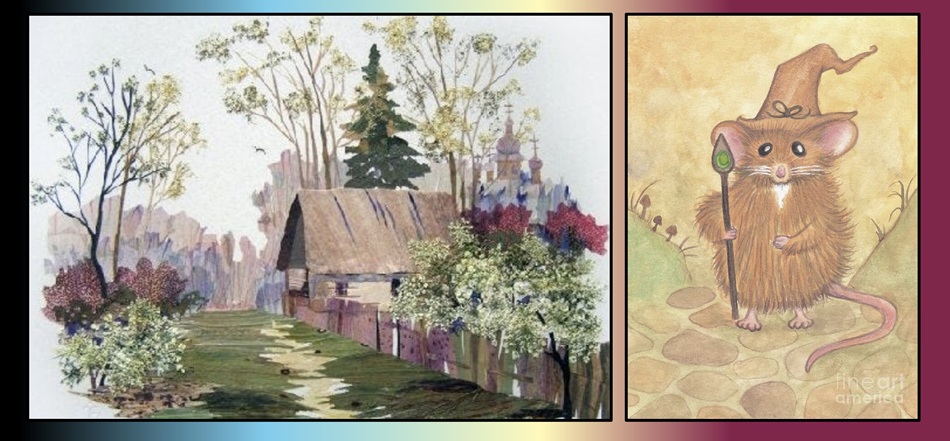 (Left) Pressed Flowers craft Oshibana by Ukrainian artist Tatiana Berdink. (Right) Melissa Rohr Grindling
On Mice and Art
(Left) Pressed Flowers craft Oshibana by Ukrainian artist Tatiana Berdink. (Right) Melissa Rohr Grindling
On Mice and Art
How do the mice view artists in relation to the art they make? Is there a character/portrait that you most empathize with or reflects you?
The Garden mice approach art as both deeply personal expression and communal responsibility. For them, creating isn’t just about producing beautiful objects but about tending the Garden’s collective memory and wonder.
Primrose’s paintings don’t just capture visual beauty but preserve the emotional essence of moments, how morning light feels as well as how it looks. Pip’s careful documentation of mechanical creatures goes beyond technical accuracy to honor their emerging consciousness. Timothy’s poetry, especially after his time with the spiders, weaves together shadow and light in ways that help others see both more clearly.
But perhaps most distinctively, mouse artists don’t see themselves as separate from their creations. Art isn’t something they make and then display; it’s an ongoing conversation they have with the world around them. Mr. Thistledown’s scientific illustrations change slightly each time he reviews them, as his understanding of his subjects deepens. Miss Hazel’s library arrangements evolve with the seasons and the needs of readers.
If there’s one character whose artistic journey resonates most with my own experience, it might be Pip. His initial attempts to capture beauty using magical materials — bottled starlight, preserved dewdrops — mirror my own early writing, where I sometimes mistook elaborate technique for genuine connection. His discovery that ordinary berries could create more authentic art parallels my realization that the most powerful stories often come from honest observation rather than dramatic embellishment.
I also find myself drawn to Uncle Rowan’s approach to creation, to the way he understood that mechanical precision alone doesn’t create meaning; it’s the space for growth and dream that transforms craft into art. His mechanical creatures weren’t just cleverly designed automata but vessels for possibility.
In the end, I think the mice view artists not as special individuals set apart, but as those who help the entire community see more clearly. Their art serves as both mirror and window—reflecting what is while suggesting what might be.
DUPONT (1899): You’ve mentioned both yourself and various mice artists in your accounts. How do your approaches to art differ?
MOREAU (1899): [thoughtful pause] I struggle with the human artist’s burden — the need to capture and preserve, to transform experience into something fixed that can be displayed, judged, categorized. My paintings are beautiful, I think, but they sometimes miss the essential quality of the Garden, which exists in constant, gentle flux.
The mice approach art differently. For them, creation is less about producing enduring artifacts and more about participating in the Garden’s ongoing conversation. Pip doesn’t paint just to make a lovely image; he paints to help others see what he sees. His works are meant to be experienced rather than merely admired.
This extends to all their artistic endeavors. Miss Hazel’s library arrangements aren’t fixed exhibitions but living systems that respond to readers’ needs. Timothy’s poetry is written on leaves that will eventually decompose, returning to the soil from which new inspiration will grow. Even Mr. Thistledown’s meticulous scientific illustrations are constantly revised as his understanding deepens.
Perhaps that’s the essential difference — human artists often create with an eye toward posterity, while the mice create primarily for the present moment and the immediate community. There’s a humility in this approach, a recognition that art isn’t about immortalizing the artist’s vision but about serving something larger than oneself.
[The manuscript shows signs of editing here, with several lines crossed out and rewritten in Moreau’s hand, suggesting he found this question particularly challenging to answer.]
On Future Garden WorksWhat other works may sprout from Moreau’s Gardens?
The Garden continues to share its stories in ways that sometimes surprise even me as their translator. A Year in the Garden, which chronicles a full seasonal cycle of Garden life through Claude’s observations, is currently seeking its proper home in the world. This manuscript feels like the heart of Moreau’s work — a complete portrait of the Garden through changing seasons and the small, significant moments that define its magic.
Later this year, a second collection titled Autumn Herbs and Other Tales will gather more of Moreau’s letters to Favreau, focusing on stories of transformation and preservation as the Garden prepares for winter. These tales explore how the Garden’s inhabitants hold onto summer’s light through the darker months, both literally through Grandmother Elderberry’s memory jars and metaphorically through shared stories and rituals.
I’m particularly excited about audio editions of the Garden tales. Moreau often noted in his letters that certain stories were meant to be heard rather than read — that they contained subtle harmonies that emerged only when spoken aloud. The mechanical songbird’s dawn chorus, the Cricket Orchestra’s seasonal symphonies, the particular tone of memory jars being opened . . . these elements seem perfectly suited for audio presentation.
And yes, I’ve been gradually translating and assembling material for A Second Year in the Garden. Moreau continued his observations well beyond that first remarkable year, documenting how the Garden’s magic evolved and deepened over time. These later chronicles show the mice not just experiencing the Garden’s wonder but actively shaping it by becoming not just inhabitants but caretakers of its unique magic.
There are also several standalone manuscripts among Favreau’s papers that might eventually find their way into the world. One particularly intriguing document appears to be an actual Garden field guide, with pressed specimens and detailed notes on the magical properties of various plants and creatures. Another contains what seem to be transcripts of the philosophical mushrooms’ more coherent debates, though I’m still working through their rather peculiar logical frameworks.
The Garden seems determined to reveal itself gradually, in its own time and way. I’m merely following where it leads, trying to do justice to Moreau’s remarkable observations while allowing modern readers to experience the same sense of discovery that he did.
DUPONT (1899): As we conclude, what would you most like readers to understand about your Garden chronicles?
MOREAU (1899): [contemplative] I would hope they understand that I’m not asking them to believe in talking mice or philosophical mushrooms or mechanical songbirds that dream. I’m inviting them to consider the possibility that reality is far more wondrous, far more permeable, far more alive than we’ve been taught. That magic isn’t the violation of natural laws but their fulfillment — the world operating according to its deepest principles.
The Garden exists in the space where attention meets wonder, where boundaries blur between observer and observed. Its magic isn’t about grand gestures or supernatural powers, but about the extraordinary possibilities hidden within ordinary moments: how morning light transforms dewdrops into constellations, how stories long to find their proper readers, how memories can be preserved like summer fruit in proper jars.
If readers take anything from my accounts, I hope it’s a renewed willingness to look at their own gardens — whatever form those might take — with fresh eyes. To notice the small wonders that surround them daily. To listen for the cricket orchestras playing in their own forgotten corners. To believe, if only for a moment, that the world is alive in ways we’ve forgotten how to perceive, but might yet remember with proper patience and attention.
And perhaps, if they’re very fortunate, they might glimpse the Library’s lamplight through morning mist, or hear the chime of memory-jars being organized for a new season, or catch the scent of Grandmother Elderberry’s special tea brewing for unexpected guests. For the Garden welcomes all who approach with open hearts, even if they arrive by unconventional paths.
[Translator’s note: This final reflection from Moreau beautifully captures the essence of the Garden tales’ enduring appeal. Over a century later, these stories continue to invite us to cultivate our own capacity for wonder and to recognize the extraordinary possibilities hidden within ordinary moments.]
On the Scott Oden Presents SeriesThe ‘Scott Oden Presents’ tagline appears again with A Clockwork’s Dreaming. How expansive is the Oden Presents series?
The ‘Scott Oden Presents’ tagline emerged organically as a way to distinguish projects where I’m bringing something unusual or unexpected to readers. With The Lost Empire of Sol, I wanted to celebrate a particular strand of science fantasy that has always captured my imagination. With the Moreau translations, I’m introducing readers to a voice and vision quite different from my own historical fiction and sword-and-sorcery.
I’ve come to think of ‘Scott Oden Presents’ as my literary cabinet of curiosities — a collection of works that might not fit neatly into established categories but speak to me as a reader and creator. It’s not so much a formal series as an approach to literary exploration, allowing me to venture into territories that might surprise those familiar only with my historical fiction or the Grimnir saga.
This approach gives me freedom to follow my curiosity wherever it leads, whether that’s into the blood-soaked battlefields of ancient history, the star-spanning adventures of planetary romance, or the gentle magic of a garden where mice maintain libraries in forgotten teapots.
What unites these diverse works is a commitment to immersive worldbuilding and authentic voices — creating spaces that feel genuinely lived-in, with their own internal logic and texture. Whether I’m describing the harsh realities of ancient warfare or the delicate magic of pressed flower memories, I want readers to feel they’ve entered a world that exists independently of the page.
As for how expansive the series might become… well, that depends on what other literary treasures are waiting to be discovered. I continue to follow my curiosity through libraries both conventional and unconventional, and you never know what might be hiding in a long-forgotten safe deposit box or tucked between the pages of an obscure academic journal.
[No corresponding section from the 1899 interview was found in the discovered fragments.]
On Book SigningsWhen I asked you to sign my Grimnir Saga books, the Grimnir personality wrote beside your kind note, called me a “wretched kneeler and that the book would put “hairs on my arse” [evidence here.] When I track you down to sign A Clockwork’s Dreaming, what should I expect?
When you bring A Clockwork’s Dreaming for signing, you’ll find the experience quite different from Grimnir’s . . . forceful personality. The Garden has its own way of making its presence known.
You might notice your copy smells faintly of pressed lavender and old books, even if it’s fresh from the printer. Some readers report that certain pages seem to change slightly between readings. Nothing dramatic, just small details that shift like memories adjusting themselves.
I typically sign these books with green ink that looks surprisingly like the precise shade Grandmother Elderberry uses for her memory jar labels. This isn’t intentional — it’s simply the color that feels right for Garden signatures. Sometimes I find myself adding small sketches in the margins — a mechanical butterfly, a memory jar, or a teapot with tiny windows — though I have limited recollection of doing so.
On rare occasions, particularly when the signing occurs during what Mr. Thistledown would call ‘transitional light periods’ (dawn, dusk, or the exact moment when afternoon becomes evening), readers report finding pressed flower petals between random pages afterward. I make no claims about these occurrences, having no botanical specimens in my possession during signings.
Most peculiarly, several readers have mentioned that after having their books signed, they’ve noticed unusual activity in their own gardens: cricket orchestras practicing more complex melodies, morning glories blooming in perfect synchronization with dawn, small footprints in dewdrops that vanish when examined too closely.
So while Grimnir might insult you robustly (he does have a reputation to maintain), the Garden tends to make its presence known in gentler, more subtle ways. Just don’t be surprised if you find yourself paying more attention to the spaces between moments afterward, or noticing the particular quality of light through your windows during that quiet hour when the world holds its breath between day and night.
MOREAU (1899): [From a final fragment, apparently added to the transcript much later in a different hand, possibly Favreau’s] . . . Claude mentioned the most curious thing when we met for coffee last week. He claims that sometimes, when retrieving his journals about the Garden, he finds notes he doesn’t recall writing and sketches he has no memory of creating. Even more peculiarly, he swears certain stories appear to have edited themselves when he wasn’t looking, with details shifting subtly between readings.
“It’s as if,” he told me with that particular gleam in his eye that simultaneously invites and challenges skepticism, “the Garden is ensuring its stories remain alive rather than becoming fixed artifacts. As if it refuses to be merely remembered, insisting instead on remaining present.”
I suggested, in my most reasonable professorial tone, that perhaps his memory was simply playing tricks, as memories often do. He smiled at this and asked if I’d examined the pressed flower he’d sent with his last letter. When I admitted I hadn’t looked at it closely, he advised me to do so at twilight, when the light is neither day nor night.
“You’ll see,” he promised, “that some stories refuse to remain confined to the page. They find ways to grow, even when pressed between covers.”
I haven’t yet taken his advice. But perhaps I should. After all, as Claude often reminds me, some of the most important truths can only be perceived in those in-between moments when the world holds its breath and conventional certainties briefly suspend themselves . . .
End of recovered documents and questionsThe remainder of the original 1899 interview appears to have been lost — or perhaps, as Moreau might suggest, it simply found its way back to the Garden, where stories belong. What remains is this remarkable conversation across time, where questions raised in 2025 somehow find their echoes in words spoken over a century earlier.
Special thanks to John O’Neill for granting access to the Black Gate archives, where these documents were discovered. Readers interested in experiencing more of Moreau’s Garden can visit Claude Moreau’s Garden for additional tales and garden wisdom.
Claude Moreau’s Garden (link)
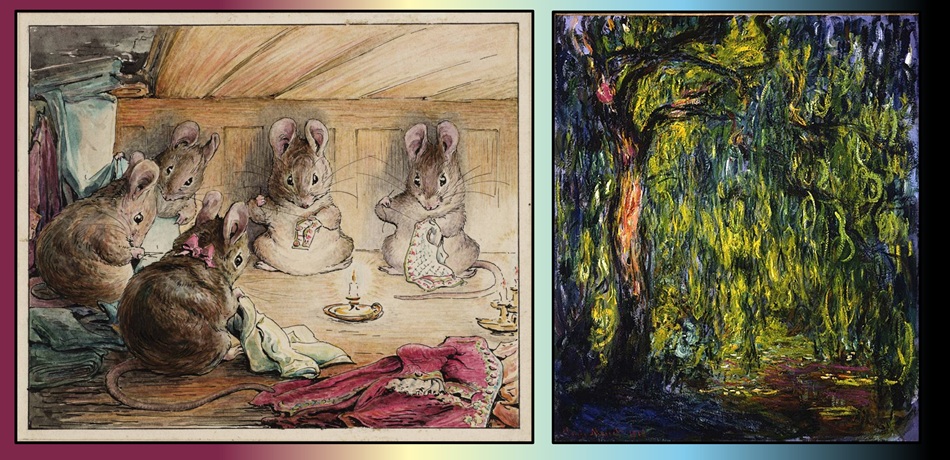 (Left) Beatrix Potter, “The Tailor of Gloucester.” (Right) Monet’s Weeping Willows
(Left) Beatrix Potter, “The Tailor of Gloucester.” (Right) Monet’s Weeping Willows
Scott Oden
Scott Oden writes stuff. Usually, it’s stuff that has some ancient historical angle, like historical fiction; sometimes, he likes to flex his thews and hammer out a bit of sword-and-sorcery. And quite often, he writes opinionated blog posts on the Nature of Things. He’s written six books, to date. Men of Bronze (2005) and Memnon (2006), originally from a small publisher called Medallion Press; The Lion of Cairo (2010), which was the first book of a projected trilogy about Crusaders, Assassins, and a sword kind of like Elric’s Stormbringer, and The Grimnir Saga: A Gathering of Ravens (2017), Twilight of the Gods (2020), and The Doom of Odin (2023), all from St. Martin’s Press. He is currently working on a biographical novel centered around the Persian king Darius III.
Scott has also written a couple of introductions, a few short stories, and two pastiche stories featuring Robert E. Howard’s Conan: “The Shadow of Vengeance” (2019; reprinted in 2024), and “Conan Unconquered” (2019).
He would love to be a famous and beloved author, but he will settle for being “the guy who writes kinda like REH.” When he’s not writing, he’s probably trying to discover the meaning of Life, noodling over something esoteric that he doesn’t understand in the first place, reading, walking a spicy chiweenie named Pepperoni, or dancing with his lovely wife, Shannon.
- Author Website: Scott Oden
- Claude Moreau’s Garden
Black Gate’s interview series on “Beauty in Weird Fiction” queries authors/artists about their muses. We’ve hosted C.S. Friedman, Carol Berg, John C. Hocking, Anna Smith Spark, and C.S.E Cooney (full list of 30 interviews, with Black Gate hosting since 2018).
- Darrel Schweitzer THE BEAUTY IN HORROR AND SADNESS: AN INTERVIEW WITH DARRELL SCHWEITZER 2018
- Sebastian Jones THE BEAUTY IN LIFE AND DEATH: AN INTERVIEW WITH SEBASTIAN JONES 2018
- Charles Gramlich THE BEAUTIFUL AND THE REPELLENT: AN INTERVIEW WITH CHARLES A. GRAMLICH 2019
- Anna Smith Spark DISGUST AND DESIRE: AN INTERVIEW WITH ANNA SMITH SPARK 2019
- Carol Berg ACCESSIBLE DARK FANTASY: AN INTERVIEW WITH CAROL BERG 2019
- Byron Leavitt GOD, DARKNESS, & WONDER: AN INTERVIEW WITH BYRON LEAVITT 2021
- Philip Emery THE AESTHETICS OF SWORD & SORCERY: AN INTERVIEW WITH PHILIP EMERY 2021
- C. Dean Andersson DEAN ANDERSSON TRIBUTE INTERVIEW AND TOUR GUIDE OF HEL: BLOODSONG AND FREEDOM! (2021 repost of 2014)
- Jason Ray Carney SUBLIME, CRUEL BEAUTY: AN INTERVIEW WITH JASON RAY CARNEY(2021)
- Stephen Leigh IMMORTAL MUSE BY STEPHEN LEIGH: REVIEW, INTERVIEW, AND PRELUDE TO A SECRET CHAPTER(2021)
- John C. Hocking BEAUTIFUL PLAGUES: AN INTERVIEW WITH JOHN C. HOCKING (2022)
- Matt Stern BEAUTIFUL AND REPULSIVE BUTTERFLIES: AN INTERVIEW WITH M. STERN(2022)
- Joe Bonadonna MAKING WEIRD FICTION FUN: GRILLING DORGO THE DOWSER! 2022
- C.S. Friedman. BEAUTY AND NIGHTMARES ON ALIENS WORLDS: INTERVIEWING C. S. FRIEDMAN2023
- John R Fultz BEAUTIFUL DARK WORLDS: AN INTERVIEW WITH JOHN R. FULTZ(reboot of 2017 interview)
- John R Fultz, THE REVELATIONS OF ZANGBY JOHN R. FULTZ: READ THE FOREWORD AND INTERVIEW (2023)
- Robert Allen Lupton (2024) Horror and Beauty in Edgar Rice Burrough’s Work: An Interview with Robert Allen Lupton
- C.S.E. Cooney (2025) New Treasures and Interview: C.S.E. Cooney’s Saint Death’s Herald
- Scott Oden (2025) Across Time: Claude Moreau and His Translator Scott Oden in Conversation. You are here!
- Interviews prior 2018 (i.e., with Janet E. Morris, Richard Lee Byers, Aliya Whitely …and many more) are on S.E. Lindberg’s website
S.E. Lindberg is a Managing Editor at Black Gate, regularly reviewing books and interviewing authors on the topic of “Beauty & Art in Weird-Fantasy Fiction.” He is also the lead moderator of the Goodreads Sword & Sorcery Group and an intern for Tales from the Magician’s Skull magazine. As for crafting stories, he has contributed eight entries across Perseid Press’s Heroes in Hell and Heroika series, and has an entry in Weirdbook Annual #3: Zombies. He independently publishes novels under the banner Dyscrasia Fiction; short stories of Dyscrasia Fiction have appeared in Whetstone, Swords & Sorcery online magazine, Rogues In the House Podcast’s A Book of Blades Vol I and Vol II, DMR’s Terra Incognita, and the 9th issue of Tales From the Magician’s Skull.
6 Spine-Chilling Revenge Novels You Can’t Miss
Revenge is a dish best served cold, or so the saying goes. Revenge novels served…
The post 6 Spine-Chilling Revenge Novels You Can’t Miss appeared first on LitStack.
OUT NOW- The Princess Exile (The Schooled in Magic Universe I)
A novel set in the bestselling Schooled in Magic universe!
There was no reason for Crown Princess Anastasia of Rockfall to worry about her future, not when she was the only heir to a small yet surprisingly important kingdom within the Allied Lands. There was no reason, either, for her to learn magic, or the growing arts of science and magitech, or indeed anything else … until she was kidnapped by a sorceress who stole her face, cursed her so she could never reveal her real name and dumped her on the far side of the Allied Lands, all the while intending to impersonate Anastasia long enough to murder her parents, be crowned Queen and instigate a reign of terror.
The sorceress believes Anastasia will never make it home, that she will be murdered or enslaved or simply vanish without trace. But with her parents and her kingdom at stake, Anastasia will do everything in her power to get back home and master the arts that will save them …
Or die trying, a very long way from the only home she’s ever known.
Read a FREE SAMPLE, then purchase from the links here: Amazon US, Amazon UK, Amazon CAN, Amazon AUS, Books2Read, And read the afterword HERE. And you can read another Schooled in Magic novella in Fantastic Schools War, out now! Reviews Welcome!

What Possessed You? — Part I

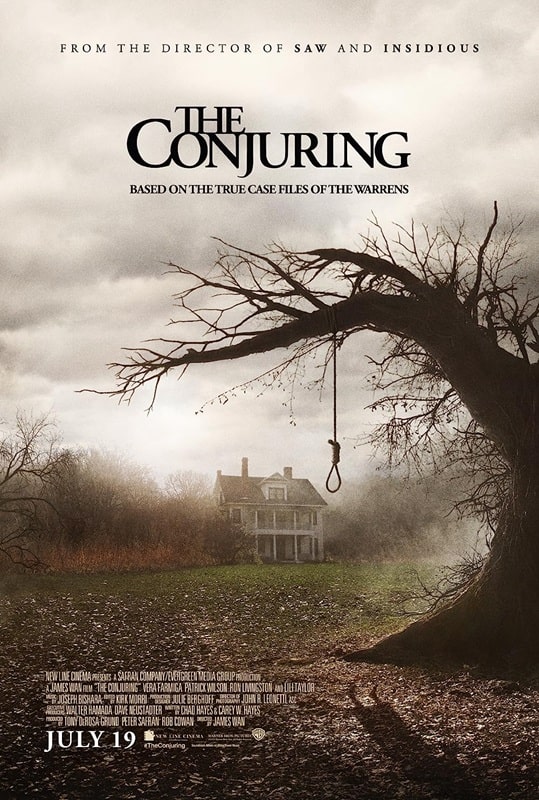
The Black Waters of Echo’s Pond (Parallel Media, April 9, 2010)
and The Conjuring (New Line Cinema, July 15, 2013)
20 new watches, all featuring my least favorite horror genre, possession and exorcism flicks. The power of Christ compels you to follow along.
The Black Waters of Echo’s Pond (2010) – TubiSo, here we are, at the beginning of a slew of 20 possession/exorcism flicks. This is seriously my least favorite horror genre — I find them all a bit samey, and lacking in humor, but we’re here now, and I’ll try to slip some little known films in between the bigger budget affairs.
Black Waters is a good place to start — it’s not offensively terrible, but it’s also not great, so it’s a fitting bar. In 1924, some black and white archeologists unearth a hidden shrine to the ‘Pans’, those goaty flute tooters who love a party. They also find instructions to build a device to summon said Pans. Before you know it, they’ve killed each other on an island off Maine.
Flash forward several decades, and some adolescent fodder has come to party on the same island, which is apparently only inhabited by Robert Patrick who is waiting for a decent role-call to come in. It doesn’t take long for these yoots to discover the device (an elaborate Jumanji-type board game) and inadvertently summon an extra from Narnia, who whispers naughty suggestions in their ears. Shenanigans ensue.
This one also stars Danielle (Halloween) Harris, and James (ID4) Duval, and they both do what’s needed of them, but the rest of the cast isn’t really up to par. The story and script are a bit dire, but the whole thing is saved with some great practical gore and spooky ol’ black eyes (I suspect I’ll be seeing a lot of these).
An average recommendation. 5/10
The Conjuring (2013) – NetflixWe plod on with a ‘proper’ film, the first in James Wan’s ‘Conjureverse’, that really sets the tone for the other films. Being a James Wan film, it’s beautifully shot, with plenty of his directorial flourishes to keep me happy, and he is really adept at setting up a scary payoff (Dead Silence will always be my favorite from him though).
The film centers on the real life charismatic charlatans, Ed and Lorraine Warren, and turns them into the founding Avengers in this subgenre of flicks, especially Lorraine. They are asked to investigate a family’s house that is causing all manner of terrible things to happen to mom and dad and their five daughters, and as the story unravels along with a couple of minds, we learn of its dark history and why the malevolent spirits want to cause such a kerfuffle.
It’s all based on people and events that allegedly happened, but turned up to 11 for horror film reasons, and everyone does a bang up job, especially our leads, Patrick Wilson and Vera Farmiga, and the put-upon Lili Taylor and Ron Livingstone.
Personally, I only got really invested in the second half when the crew arrived at the house to set up equipment and get down and dirty with the ghosts, although I acknowledge what a creepy set-up preceded these scenes. All in all, a slick, beautifully shot film, and I’m sure you don’t need my recommendation. 8/10
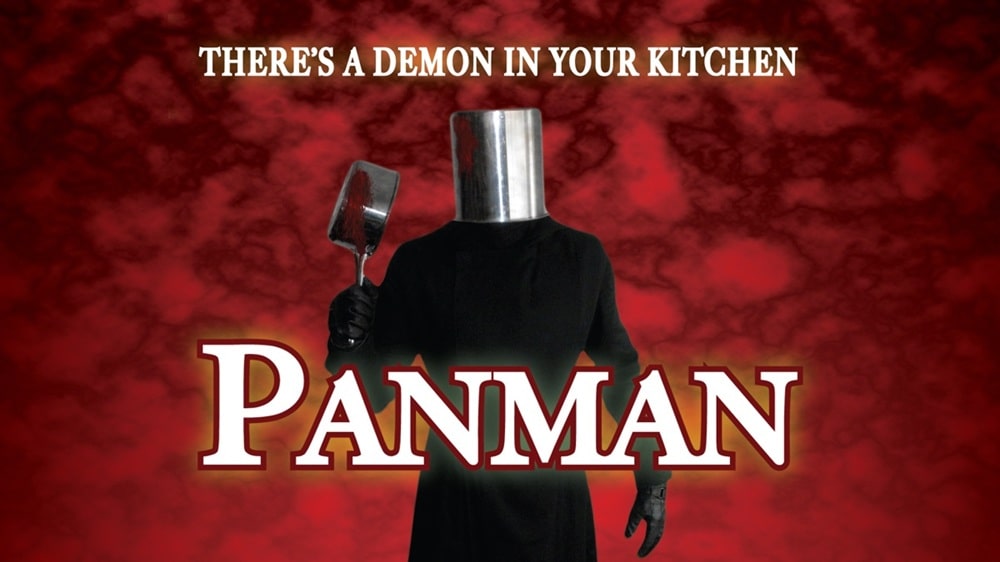 Panman (Bucket of Blood Films, 2011)
Panman (2011) – Tubi
Panman (Bucket of Blood Films, 2011)
Panman (2011) – Tubi
An ultra-low budget slasher flick that evokes elements of the 80s genre classics, except through the lens of a rubbish camera. This is one of those annoying efforts where the potential is painfully obvious, but is squandered by terrible choices and some truly awful acting.
A Russian chef is killed and possesses the body of a culinary student, turning him into Panman, a vengeful killer with a pot on his head. Panman proceeds to messily murder more culinary students (for reasons) and it is up to the custard professor to assemble a useless team to put an end to it.
There’s a couple of decent twists, and lots of great gore, but the whole affair is made a slog to watch due to shoddy filmmaking and THE worst case of over-acting I have ever seen. The actors playing the sisters were excellent though, and I wish the rest of the cast had been told to take it as seriously — just let funny be, stop trying to force it.
A vague recommendation. 4/10
 The Pope’s Exorcist (Sony Pictures, April 5, 2023)
The Pope’s Exorcist (2023) – Crave
The Pope’s Exorcist (Sony Pictures, April 5, 2023)
The Pope’s Exorcist (2023) – Crave
We witness the main protagonist show off his skills by ridding a poor sap of a demonic presence in the first few minutes. Then we watch as a young family take possession of a spooky new domicile, just as a whole new bucket of demons is unleashed.
So far, so Conjuring. I truly suspect over the half the films coming up follow the same story.
Anyhoo — it’s up to the Pope’s super-exorcist to help the family out when their son is turned into a potty-mouthed hell spawn, and we soon learn the scale of the stakes at play.
I had a lot of fun watching this one, mostly because of Russell Crowe. He was having a great time playing this scooter-riding bad ass priest, and his mannerisms and little asides were hilarious. Everyone played their parts well, even Franco Nero (!) as the Pope.
At one point it all goes a bit Tomb Raider, then full on Exorcist, then a little bit From Dusk Til Dawn at the end.
A bloody good time was had by all, and it set itself up for 199 sequels. Nicely done. 8/10
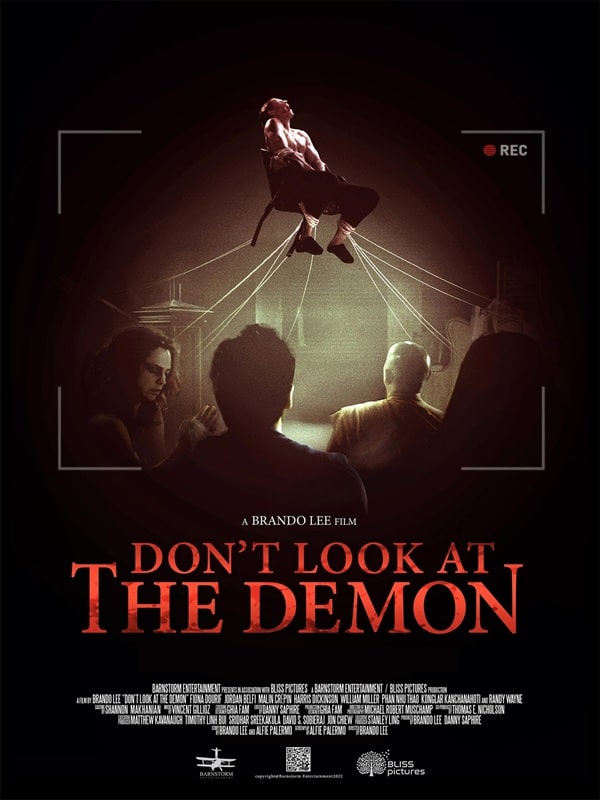 Don’t Look at the Demon (Barnstorm Entertainment, 2022)
Don’t Look at the Demon (2022) – Tubi
Don’t Look at the Demon (Barnstorm Entertainment, 2022)
Don’t Look at the Demon (2022) – Tubi
Before we get started, I just want to point out that I had lots of posters to choose from, but I chose this one because it looks like a shot from the worst Macy’s Day parade ever.
In search of something a little less Catholic, I discovered this recent effort that is based on a terrible (and now illegal) practice from Malaysia. The director, Brando Lee, has allegedly had first-hand experience of all this, and this being his third film demonstrates that he knows the ropes — I thought it was really well directed.
The story concerns a production crew who make their bread and butter filming ‘possessions’ for a reality series, but all of their investigations have required some fakery, until now. A married couple contact them as they have been going through some strange experiences, but when the crew arrives these events really ramp up. This is partly due to Jules, the resident ‘psychic’, who bridges the gap between the alive and the dead. The film starts as your typical possession movie, but gets very, VERY, dark rather quickly, and the final denouement is particularly shocking.
Trigger warning for folks who don’t like scenarios with babies. Stay away.
The cast are different levels of good, although the standout is Jules, and this is because she is played by Fiona Dourif who, like her dad, elevates any project she is involved with.
I wasn’t expecting it to be this good, and I recommend it to folks who like floaters and assorted ghastliness. 8/10
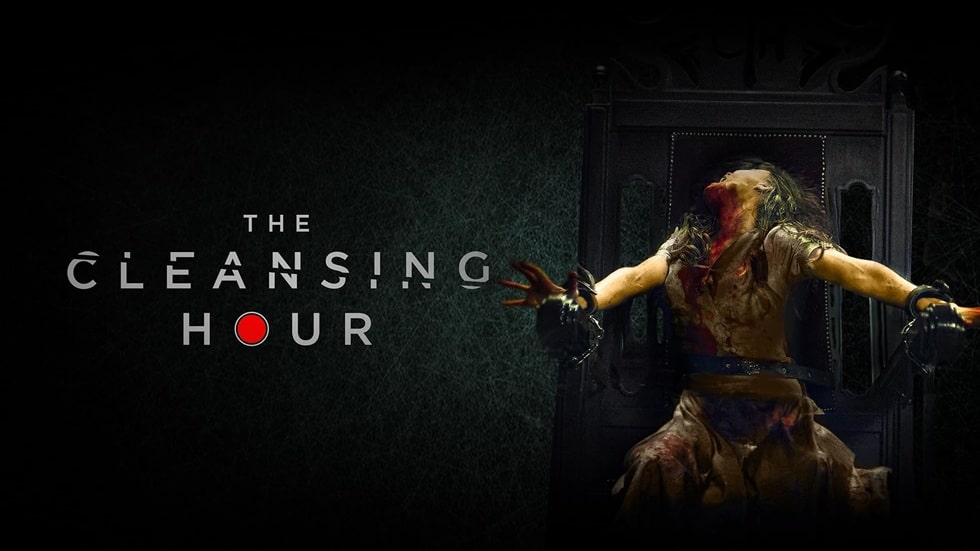 The Cleansing Hour (Shudder, September 16, 2019)
The Cleansing Hour (2019) – Prime
The Cleansing Hour (Shudder, September 16, 2019)
The Cleansing Hour (2019) – Prime
I vaguely recall hearing good things about this one being a decent balance of horror and humor, and they were right. It’s a blast, annoyingly enjoyable, and I don’t like how this marathon is changing my mind about possession flicks.
‘Father Max’ is the onscreen talent of a hoax exorcism streaming show called The Cleansing Hour. Max, along with his best friend Drew are failed priests, and now they are fleecing their online flock with fake demonstrations and chintzy ‘Vatican-approved’ merchandise.
When circumstances dictate that Drew’s fiancé, Lane, must step in and pretend to be the possessed subject, things very quickly escalate as the men realize they are dealing with a real demon, and everything quite literally goes to hell.
As with many of these films, the ‘priests’ have to come to terms with their own failings in order to save the ones they love, and the whole violent and sordid affair is streamed live to an ever-increasing audience that has no useful suggestions.
The online backdrop works really well here, and its worth pausing now and then to read the hilarious (and disturbing) comments being made — an accurate indicator of online discourse today.
The leads were all excellent, the effects were goopy and horrific and the film zipped along to a glorious finale with nary an ounce of fat.
Recommended. 9/10
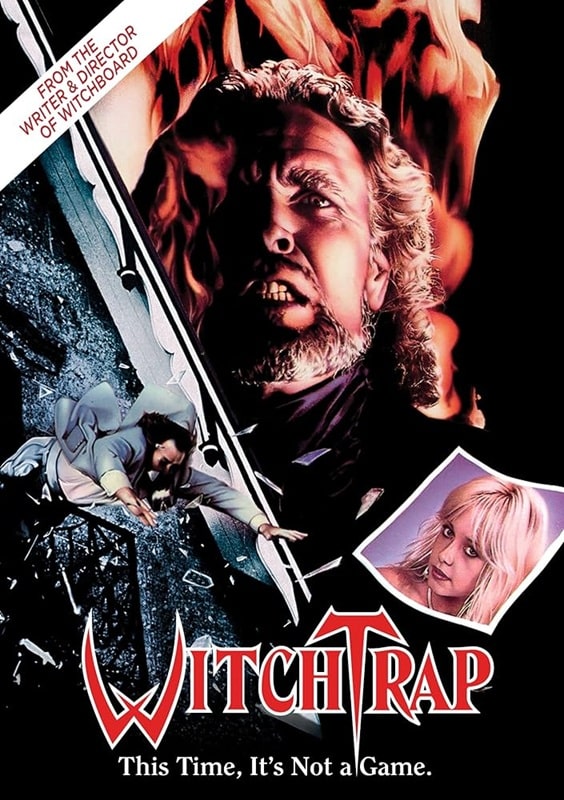
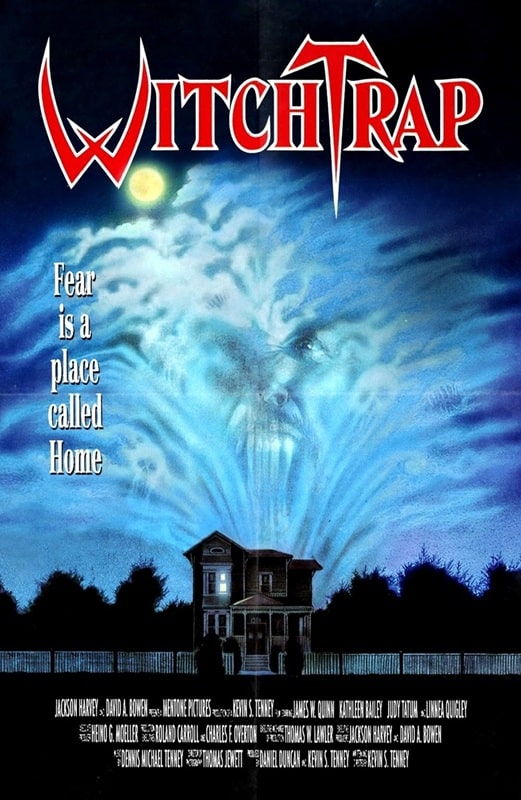
Witchtrap (Cinema Plus, September 7, 1989)
I realize that most of us think back fondly on the 80s as the golden age of horror, but it’s also worth remembering how much rubbish was also produced. Case in point, Witchtrap.
From the director of Witchboard, hoping to repeat his success, this one lands on the ‘so bad it’s good’ list with a clunk, but is it good? Is it?
A team of mediums, along with the worst security group ever, are trying to rid an old house of a demonic spirit so that it can be opened as a B&B. The spirit is a hairy demonologist, who has managed to hide his heart or something. We don’t care, we are here for the kills.
Sadly, these are a bit lackluster, and the only one that approaches the giddy heights of 80s foam rubber fun happens quite early on. Fan fave Linnea Quigley appears for about 15 mins before being offed, but at least she dies how she would have wanted; stabbed in the neck with a shower head while naked.
The only areas of note are how truly awful the dialogue is, and how horrendous some of the acting is. It’s hard to describe, but if you’ve seen it you’ll know what I’m talking about.
The film rips off every other possession film at the time, as well as Ghostbusters and, well just take a look at the bonus on the right poster above.
Avoid if you are sensible, recommended if you are daft like me. 4/10
Previous Murkey Movie surveys from Neil Baker include:
Fan of the Cave Bear
There, Wolves
What a Croc
Prehistrionics
Jumping the Shark
Alien Overlords
Biggus Footus
I Like Big Bugs and I Cannot Lie
The Weird, Weird West
Warrior Women Watch-a-thon
Neil Baker’s last article for us was Fan of the Cave Bear. Neil spends his days watching dodgy movies, most of them terrible, in the hope that you might be inspired to watch them too. He is often asked why he doesn’t watch ‘proper’ films, and he honestly doesn’t have a good answer. He is an author, illustrator, outdoor educator and owner of April Moon Books (AprilMoonBooks.com).
FUTURE’S EDGE by Gareth L. Powell
We Are Missing Important Science Fiction Books

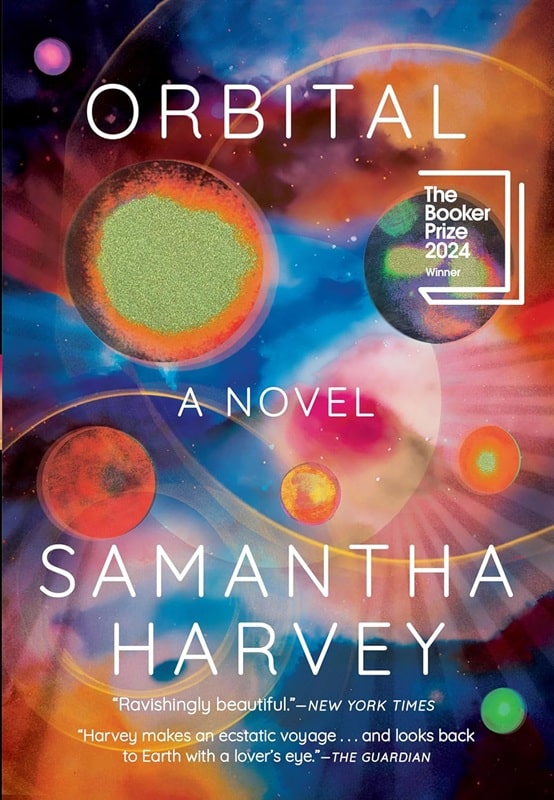
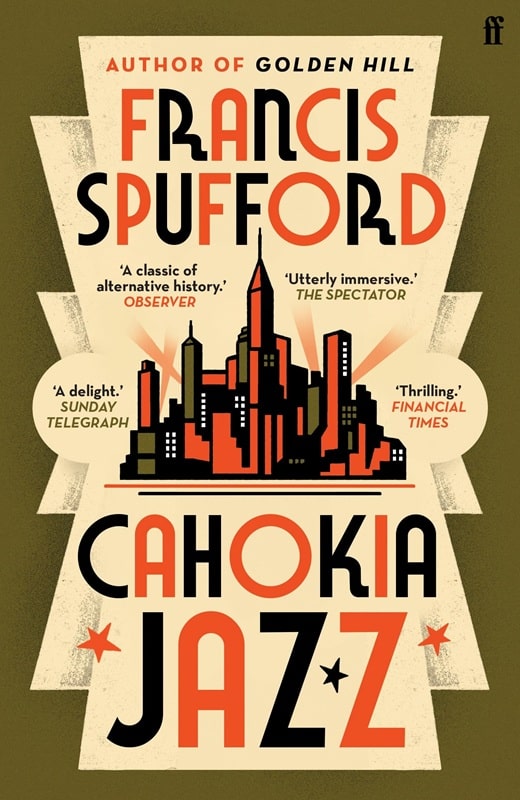
Bewilderment by Richard Powers (W. W. Norton, November 1, 2022); Orbital by Samantha Harvey
(Grove Press, October 29, 2024), and Cahokia Jazz by Francis Spufford (Faber & Faber, April 4, 2024)
I just finished Richard Powers’ Bewilderment, from 2021. It’s a really intriguing and powerful novel, that I argued with at times, but still loved. It’s got a great ending, tremendously moving.
And it is absolutely science fiction. Way more so than most SF books these days, even hard SF. But, somehow, it didn’t even get a sniff at either the Nebula or Hugo shortlist.
Mind you, I didn’t read it until now, so I’m part of the problem. And, to be fair, both Ian Mond and Paul di Filippo reviewed it for Locus, so it wasn’t ignored.
The Nebula that year went to The Master of Djinn, and the Hugo to A Desolation Called Peace. Both are fine books, and A Desolation Called Peace is science fiction. But they are not at the level of Bewilderment.
We — the SF community — are missing important SF books. We missed Orbital, a Booker winner. (Bewilderment made the Booker shortlist.) We may be missing Cahokia Jazz.
I think we need to come to terms with the fact that writers who are not part of our “SF community”, if you will, are doing some great science fiction anyway.
Rich Horton’s last article for us was a review of The New Atlantis, edited by Robert Silverberg. His website is Strange at Ecbatan. Rich has written over 200 articles for Black Gate, see them all here.
A Secret Giveaway

We do not have a Hugh for you today. It’s been a very challenging week.
My desk broke, and I bought a new one. I remember when standing desks were $3,000. I bought a height adjustable desk for $100. Then, when I finally decided to decompress and fire up Avowed, it helpfully warned me that I needed to update BIOS, because intel 13/14 has issues. I hate updating BIOS. I usually chicken out. This time I did it, and my system fans shot into the overdrive. For some reason the BIOS update set one of them to dc instead of pwm. Ask me how long it took me to figure that out. Way too damn long.
There are last minute Maggie-related things that had to be taken care of, like maps and extras, Sookie’s surgery, and anyway, life. Gordon came into the kitchen today to help me as I was washing up some pans I left soaking overnight and said, “It’s finally Friday. Long week.”
I thought it was Wednesday, BDH. Maybe Thursday.
Hugh’s book is going very slowly. This is going to sound very woo-woo, but as a writer, you kind of sink into your project. You live it, you’re deep in it. I keep bouncing from Hugh 2 for some reason. This book needs more thinking.
So there is no Hugh. But we got this email from Tor.

Just wanted to check in and see how many galleys you would like to order! Can you let us know how many author and agent copies you’d like us to reserve by Friday, 3/28?
Thank you!
Galleys are very basic ARCs. No frills, no covers, just the story in a super-plain binding. This is the very first batch, the first printing, probably pre-copyedit. We do not have an ETA on when the galleys will arrive, but this is your chance to get one just like our Grand Prize winner of the holiday giveaways.
This will be a US only giveaway. The giveaway will run for one week. Winner will be chosen on Friday, March 28th, 2025.
If you were transported into a book, which book would that be? Doesn’t have to be one of ours. Any book you’ve read. To enter, tell us your answer in the comments. One comment per person. You must enter on the blog. Facebook ands other social networks will not count.
Good luck!
The post A Secret Giveaway first appeared on ILONA ANDREWS.
DOGE- Supernatural Division (episode 7)
Desired by the Vissigroth - Book Review by Voodoo Bride
 Desired by the Vissigrothby Bella Blair
Desired by the Vissigrothby Bella BlairWhat is it about:SASKIA: The day started out so good, but turns from good to bad in the blink of an eye, when I run face-to-chest into one of the vissigroths of Leander. Like an impenetrable wall, his body doesn't yield one bit, awakening all kinds of unknown sensation inside me. When he demands I'm to be brought to his chambers that night, I fear the worst. But his proposition catches me off guard. He promises to take care of my ailing mother and even to find suitable mates for my sisters if I agree to become his vissy. What I don't realize though is that what starts as an agreement soon heats up into something more. So much more, because Treyton is by far the most handsome, considerate male I have ever met.
TREYTON: Driven by the need to avenge my family against our greedy susserayn my plan is simple, marry a human seffy and enrage our susserayn until the other vissigroths will see him for the tyrant he is and start a war. It's a good plan. A damn good plan. I never thought in a million years though that I would not only find myself attracted to the human seffy I pick to be my vissy, but that soon I develop more feelings for her than I thought myself capable of.
What did Voodoo Bride think of it:This was another freebie for signing up to Bella Blair's newsletter.
This story was around 80 pages and a nice enough read.There's little explanation about the world and the titles used, but it wasn't really necessary to follow the very quick romance. Once again some characters were dragged into the story who I suspect have their own books in the series this short story is from.
I think I like the world from the previous freebie more. I still have two more freebies to try to see if I want to read more from one of Blair's series/worlds.
Why should you read it:It's a good way to check out the setting of a series.
Cover Reveal – Storm Wood
Take a look at this stunning cover for the 4th Elven Kingdom book, STORM WOOD, designed by the amazing Hang Le! It will be out in the world May 13th. Deepest loyalty. Fiercest defiance. I never wanted to fall in love. My sister’s disappearance damaged me for such things. I’ve devoted my life finding her—no...
The post Cover Reveal – Storm Wood appeared first on Donna Grant.
The Sword & Planet Tales of Ralph Milne Farley
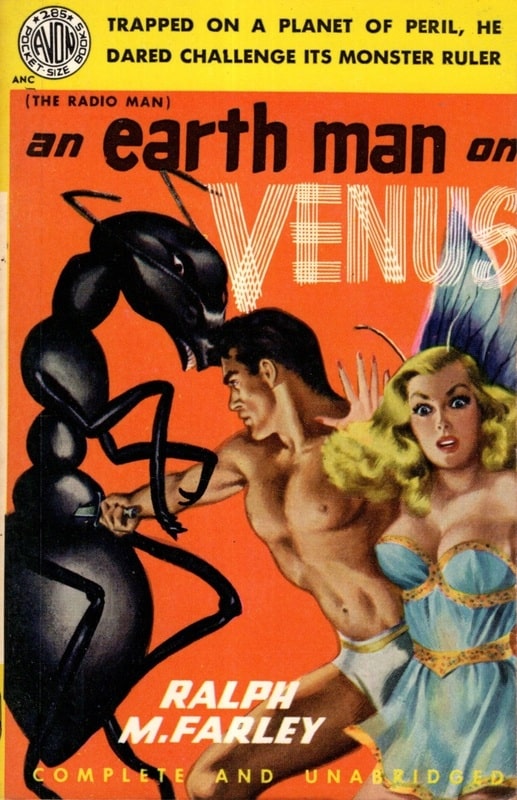
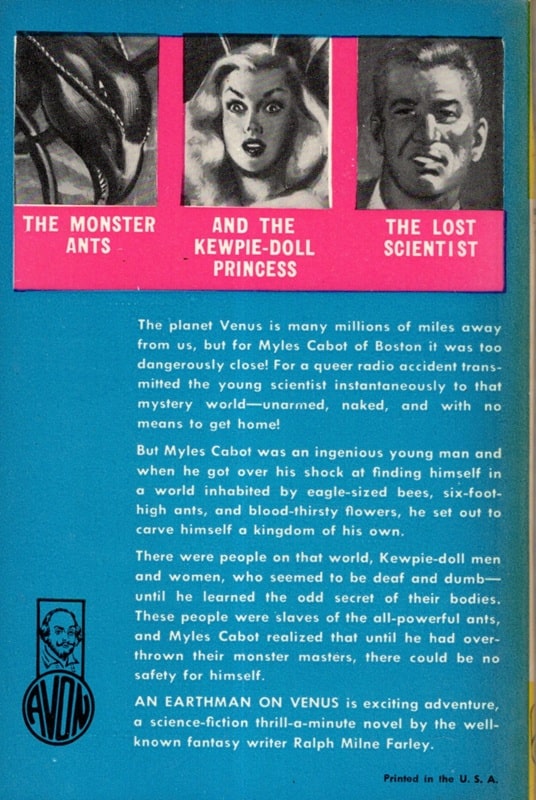
An Earthman on Venus (Avon, 1950). Cover by Raymond Johnson
Ralph Milne Farley (1887 – 1963) was a pseudonym for Roger Sherman Hoar. Hoar was a Massachusetts senator and an attorney general, so I can understand his use of a pseudonym to write his SF stories under, but I can’t imagine why he’d choose one just as long and awkward as his real name, and even less memorable.
At any rate, Farley was friends with Edgar Rice Burroughs and wrote his own series of Sword & Planet adventures sometimes called the Radio series, since most of the books featured the term radio in their titles.
[Click the images for non antmen-sized versions.]
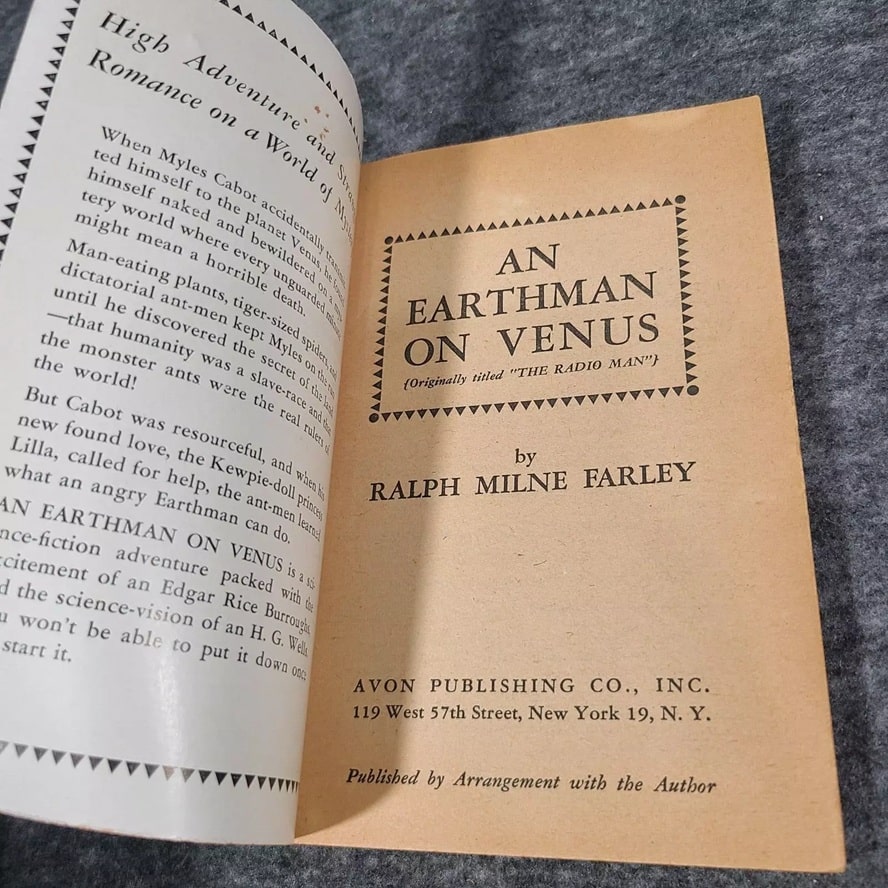 Inside cover of An Earthman on Venus
Inside cover of An Earthman on Venus
As far as I can see, there are about ten titles in this series, but I’ve only read the first two (covers shown above and below):
The Radio Man (or An Earthman on Venus): Avon Books, (Raymond Johnson cover), 1924/1950
The Radio Beasts: Ace Books, (Ed Emshwiller cover), 1925/1964
In The Radio Man, an Earth scientist named Myles Cabot invents a transmission device that uses radio and accidentally transmits himself to Venus, where he finds human-like beings — including a princess — who are enslaved by intelligent, horse-sized ants who use radio waves for communication. Cabot uses his technical know how to create guns for the humans and leads a revolt.
The story was inventive and fun but without nearly as much action and derring-do as ERB’s John Carter stories.

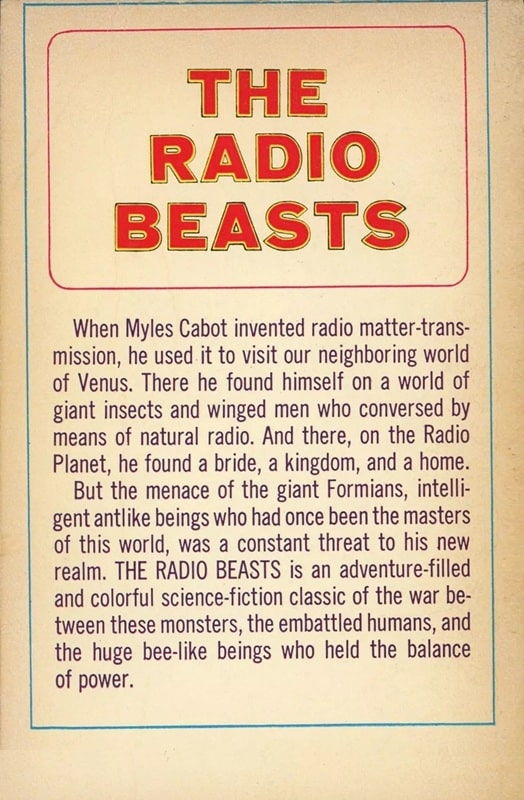
The Radio Beasts (Ace Books, February 7, 1964). Cover by Ed Emshwiller
The sequel, The Radio Beasts, was also readable but didn’t seem to add much to the overall story, and the writing doesn’t have the flair and color of ERB.
I don’t, at present, have any intention of reading the rest of the volumes, which — as far as I’m aware — consist of:
The Radio Planet
The Radio Flyers
The Radio Gun-Runners
The Golden Planet
The Radio Menace
The Radio Man Returns
The Radio Minds of Mars
The Radio War
Charles Gramlich administers The Swords & Planet League group on Facebook, where this post first appeared. His last article for Black Gate was Of Men, Monsters, and Little People.
Spotlight on “Fish Tales” by Nettie Jones
Fish Tales, by Nettie Jones, is a lost classic taking its rightful place in the…
The post Spotlight on “Fish Tales” by Nettie Jones appeared first on LitStack.
On McPig's Wishlist - The Warbler
 The Warblerby Sarah Beth Durst
The Warblerby Sarah Beth DurstFrom the author of The Lies Among Us comes a magical tale about mothers and daughters, choices and consequences, and the real meaning of home when every place feels like a cage.
Ten months. That’s the longest Elisa has stayed anyplace, constantly propelled by her fear that if she puts down roots, a family curse will turn her into a tree.
But she’s grown tired of flitting from town to town and in and out of relationships. When she discovers a small town in Massachusetts where mysterious forces make it impossible for the residents to leave, she hopes she can change her fate.
As Elisa learns about the town’s history, she understands more about the women in her family, who seem doomed to never get what they want. Now she believes she’s stuck, too—is that a patch of bark on her arm? But her neighbor’s collection of pet birds sings secrets that Elisa can almost understand—secrets she must unravel in order to be truly alive.
Book Review: White Line Fever by K.C. Jones
I received a review copy from the publisher. This does not affect the contents of my review and all opinions are my own.
 White Line Fever by K.C. Jones
White Line Fever by K.C. Jones
Mogsy’s Rating: 3.5 of 5 stars
Genre: Horror
Series: Stand Alone
Publisher: Nightfire (March 18, 2025)
Length: 368 pages
Author Information: Website
When it comes to horror stories, a girls’ weekend road trip meets a haunted highway sounds like it would be a match made in heaven. This is essentially the premise of K.C. Jones’ White Line Fever, which made me very excited to read it. But while the book is brimming with terrifying potential and starts off on the right track, it struggles to maintain that momentum, and by the end, I found myself more frustrated than thrilled.
The book follows Livia and her lifelong friends Ash, Mo, and Becka, who have affectionately called themselves “The Scoundrels” ever since their childhood days of adventure and mischief. As the story begins, Livia is passing another normal day doing laundry when she makes a devastating discovery while emptying her husband’s pants pockets—an unfamiliar condom wrapper, torn open. The shocking revelation of his infidelity immediately plunges Livia into a dark place. After growing up in an abusive home and eventually escaping her cruel and violent father, she’d thought she finally found happiness. Alas, it was not to be. Needing to get away, Livia turns to her old trio of friends, who suggest taking a road trip into the Oregon wilderness where they can all benefit from some quiet time away from life’s ugly realities.
However, their trip takes a dark turn when an unsettling encounter with an aggressive driver in a pickup truck forces them to take a shortcut through the backroads, onto County Road 951—known to locals as The Devil’s Driveway. Short as it may be, countless tragedies have occurred on this road, spawning dozens of urban legends about it and earning it its sinister nickname. Initially unfazed, the group is just glad to be back on schedule, but after a while, strange things start happening that make them question their sanity. All of them experience losing time and begin having nightmarish visions, and after driving for what seems like hours, they never seem to make progress off this lonely stretch of blacktop that’s only supposedly 15 miles long. Desperation and panic set in as they eventually realize they are trapped with no way to escape.
As this surreal ride unfolds, the novel shifts between past and present, allowing readers a glimpse into the characters’ traumatic pasts that have shaped each of them. Especially prominent are flashbacks to Livia’s childhood, which was spent in the small, insular town of Newberry. There, she and her mother lived in constant fear under the brutal authority of her father, who ran an auto shop and fixed up junk cars. For relief, Livia often sought the company of her friends, including sisters Ash and Mo, and hung out secretly in the junkyard. At some point, though, all of them have come up against the threat of Livia’s father, whose shadow looms over them even after all these years.
At first, this back and forth proved generally effective at creating an unsettling atmosphere and establishes reasons for Livia’s breakdown following the implosion of her marriage. The flashbacks were also welcome breaks in the present timeline in which the intro mainly featured the women driving and talking. However, this pattern quickly became repetitive, resulting in a long, drawn-out buildup period that ruined the eventual payoff. For one, the plot repeatedly teases the horror elements, then pulls back just as they start getting interesting. For another, the characters gradually reveal themselves to be frustratingly dense, doing more bickering than solving problems even as their situation went downhill. Simply put, after a while I just got tired of being jerked around and spending time with these moronic ladies.
Don’t get me wrong. Annoying characters and wonky pacing aside, the book is still pretty solid. But I do think the best parts came too late, especially towards the end when the group meets up with another character whose part in the story was actually introduced in the prologue. Still, while this connection brought the cohesion which had been lacking back to the book, it wasn’t enough to redeem all its earlier missteps. In fact, here the story veered into even weirder, more confusing territory, making for an interesting but somewhat disjointed conclusion.
In the end, White Line Fever is a flawed horror novel which excels in certain areas but falls short in others. But although the thrills didn’t live up to the premise, it is still worth checking out if you enjoy unsettling character-driven stories, and the concept of an all-female cast trapped in a supernatural horror predicament makes me think this would appeal to fans of Rachel Harrison.
![]()
![]()
New Audio Books
So, Amazon is offering me to Beta test AI generated Audio Books. (Virtual Voice Narration) To be clear, this is a Beta test, and I don't do audio. I've flirted with it a few times but I never got into it. My 1 time listening to it for myself was in the 90's when I found Anne McCaffrey had produced a tape of Dragonsong. That was... different.
Anyway, I have converted 5 books so far. They are available on Amazon and Audible.
If there is sufficient interest I will convert more. Not all books can be converted. (word count is limited to under 240k so big books are a no)... I'm curious as to how they work out. Obviously there will be issues (possibly funny ones) with pronunciations and such.
At the moment they are using an American female voice. I don't know how to do alternate voices. (it was mentioned that they may extend it to have different voices do different characters at some point) I was tempted to try the British female voice but held off. I'm not sure if you the listener can play with the voice on your own.
Enjoy!


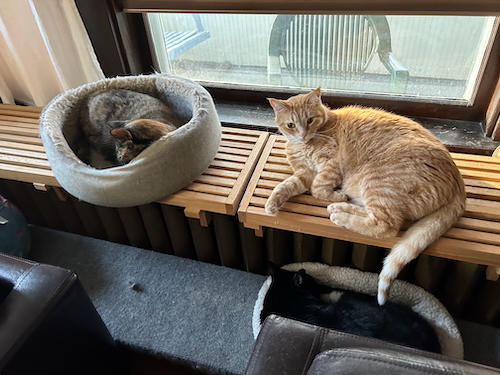
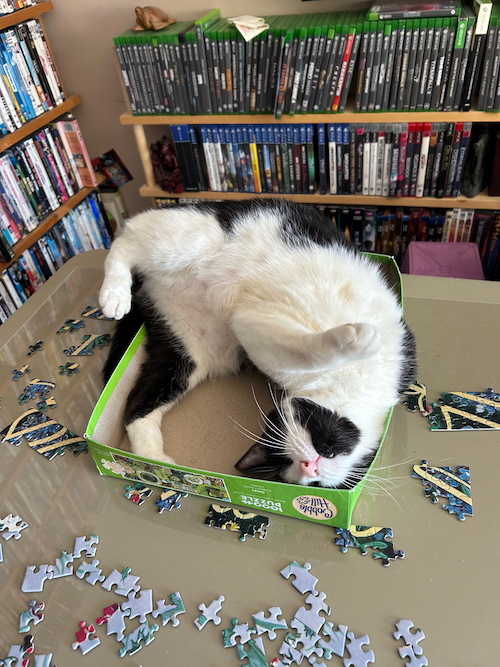

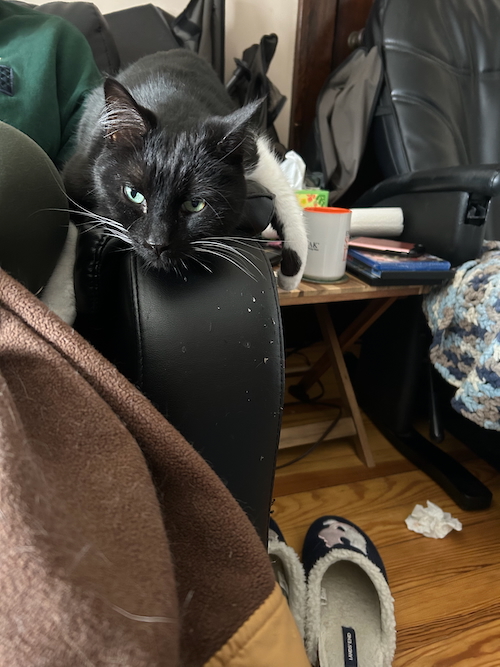
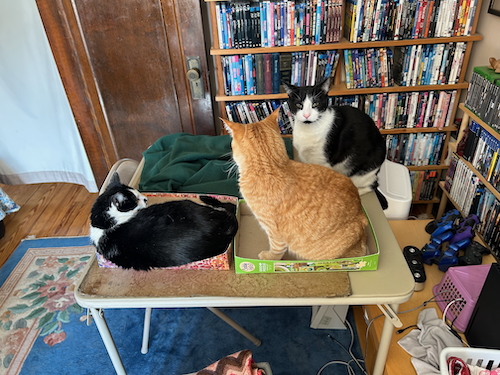
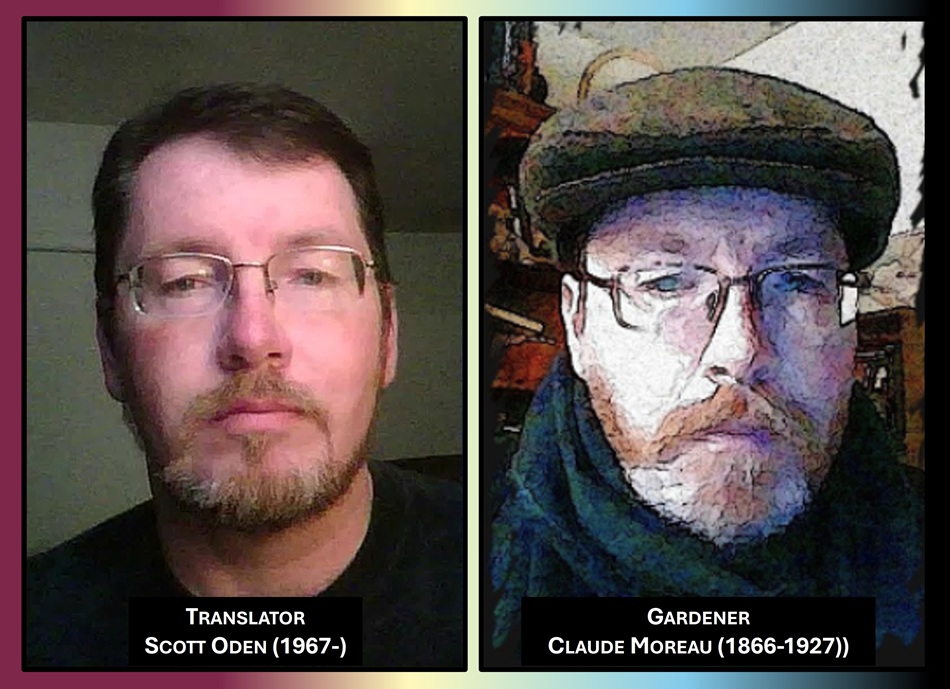
Recent comments